|
5-4-1.
Standard Terminal Arrival (STAR), Area Navigation (RNAV)
STAR, and Flight Management System Procedures (FMSP) for
Arrivals
a. A STAR is
an ATC coded IFR arrival route established for application
to arriving IFR aircraft destined for certain airports. RNAV
STAR/FMSP procedures for arrivals serve the same purpose but
are only used by aircraft equipped with FMS or GPS. The
purpose of both is to simplify clearance delivery procedures
and facilitate transition between en route and instrument
approach procedures.
1. STAR/RNAV
STAR/FMSP procedures may have mandatory speeds and/or
crossing altitudes published. Other STARs may have planning
information depicted to inform pilots what clearances or
restrictions to "expect." "Expect"
altitudes/speeds are not considered STAR/RNAV STAR/FMSP
procedures crossing restrictions unless verbally issued by
ATC.
NOTE-
The "expect" altitudes/speeds are
published so that pilots may have the information for
planning purposes. These altitudes/speeds shall not be used
in the event of lost communications unless ATC has
specifically advised the pilot to expect these
altitudes/speeds as part of a further clearance.
REFERENCE-
14 CFR Section 91.185(c)(2)(iii).
2. Pilots
navigating on STAR/RNAV STAR/FMSP procedures shall maintain
last assigned altitude until receiving authorization to
descend so as to comply with all published/issued
restrictions. This authorization will contain the
phraseology "DESCEND VIA."
(a) Clearance
to "descend via" authorizes pilots to:
(1) Vertically
and laterally navigate on a STAR/RNAV STAR/FMSP.
(2) When
cleared to a waypoint depicted on a STAR/RNAV STAR/FMSP, to
descend from a previously assigned altitude at pilot's
discretion to the altitude depicted for that waypoint, and
once established on the depicted arrival, to navigate
laterally and vertically to meet all published restrictions.
NOTE-
1. Air traffic is responsible for obstacle
clearance when issuing a "descend via" instruction to the
pilot. The descend via is used in conjunction with
STARs/RNAV STARs/FMSPs to reduce phraseology by not
requiring the controller to restate the altitude at the next
waypoint/fix to which the pilot has been cleared.
2. Air
traffic will assign an altitude to cross the waypoint/fix,
if no altitude is depicted at the waypoint/fix, for aircraft
on a direct routing to a STAR/RNAV STAR/FMSP.
3. Minimum
en route altitudes (MEA) are not considered restrictions;
however, pilots are expected to remain above MEAs.
EXAMPLE-
1. Lateral/routing clearance only.
"Cleared Hadly One arrival."
2. Routing with
assigned altitude.
"Cleared Hadly One arrival, descend and maintain
Flight Level two four zero."
"Cleared Hadly One arrival, descend at pilot's discretion,
maintain Flight Level two four zero."
3.
Lateral/routing and vertical navigation clearance.
"Descend via the Civit One arrival."
"Descend via the Civit One arrival, except, cross Arnes at
or above one one thousand."
4.
Lateral/routing and vertical navigation clearance when
assigning altitude not published on procedure.
"Descend via the Haris One arrival, except after
Bruno, maintain one zero thousand."
"Descend via the Haris One arrival, except cross Bruno at
one three thousand then maintain one zero thousand."
5. Direct
routing to intercept a STAR/RNAV STAR/FMSP and vertical
navigation clearance.
"Proceed direct Mahem, descend via Mahem One
arrival."
"Proceed direct Luxor, cross Luxor at or above flight level
two zero zero, then descend via the Ksino One Arrival."
NOTE-
1. In Example 2, pilots are expected to
descend to FL 240 as directed, and maintain FL 240 until
cleared for further vertical navigation with a newly
assigned altitude or a "descend via" clearance.
2. In
Example 4, the aircraft should track laterally and
vertically on the Haris One arrival and should descend so as
to comply with all speed and altitude restrictions until
reaching Bruno and then maintain 10,000. Upon reaching
10,000, aircraft should maintain 10,000 until cleared by ATC
to continue to descend.
(b)
Pilots cleared for vertical navigation using the
phraseology "descend via" shall inform ATC upon initial
contact with a new frequency.
EXAMPLE-
"Delta One Twenty One leaving FL 240, descending via the
Civit One arrival."
b. Pilots of
IFR aircraft destined to locations for which STARs have been
published may be issued a clearance containing a STAR
whenever ATC deems it appropriate.
c. Use of
STARs requires pilot possession of at least the approved
chart. RNAV STARs must be retrievable by the procedure name
from the aircraft database and conform to charted procedure.
As with any ATC clearance or portion thereof, it is the
responsibility of each pilot to accept or refuse an issued
STAR. Pilots should notify ATC if they do not wish to use a
STAR by placing "NO STAR" in the remarks section of the
flight plan or by the less desirable method of verbally
stating the same to ATC.
d. STAR charts
are published in the Terminal Procedures Publications (TPP)
and are available on subscription from the National
Aeronautical Charting Office.
e. RNAV STAR.
1. All public
RNAV STARs are RNAV1. These procedures require system
performance currently met by GPS or DME/DME/IRU RNAV systems
that satisfy the criteria discussed in AC 90-100A, U.S.
Terminal and En Route Area Navigation (RNAV) Operations.
RNAV1 procedures require the aircraft's total system error
remain bounded by +1 NM for 95% of the total flight
time.
(a) Type A.
These procedures require system performance currently met by
GPS, DME/DME, or DME/DME/IRU RNAV systems that satisfy the
criteria discussed in AC 90-100, U.S. Terminal and En Route
Area Navigation (RNAV) Operations. Type A terminal
procedures require the aircraft's track keeping accuracy
remain bounded by 2 NM for 95% of the total flight time.
NOTE-
If not equipped with GPS (or for multi-sensor systems with
GPS which do not alert upon loss of GPS), aircraft must be
capable of navigation system updating using DME/DME or
DME/DME/IRU for Type A STARs.
(b) Type B.
These procedures require system performance currently met by
GPS or DME/DME/IRU RNAV systems that satisfy the criteria
discussed in AC 90-100. Type B procedures may require the
aircraft's track keeping accuracy remain bounded by 1 NM for
95% of the total flight time.
NOTE-
If not equipped with GPS (or for multi-sensor systems with
GPS which do not alert upon loss of GPS), aircraft must be
capable of navigation system updating using DME/DME/IRU for
Type B STARs.
2. For
procedures requiring GPS, if the navigation system does not
automatically alert the flight crew of a loss of GPS, the
operator must develop procedures to verify correct GPS
operation.
5-4-2.
Local Flow Traffic Management Program
a. This
program is a continuing effort by the FAA to enhance safety,
minimize the impact of aircraft noise and conserve aviation
fuel. The enhancement of safety and reduction of noise is
achieved in this program by minimizing low altitude
maneuvering of arriving turbojet and turboprop aircraft
weighing more than 12,500 pounds and, by permitting
departure aircraft to climb to higher altitudes sooner, as
arrivals are operating at higher altitudes at the points
where their flight paths cross. The application of these
procedures also reduces exposure time between controlled
aircraft and uncontrolled aircraft at the lower altitudes in
and around the terminal environment. Fuel conservation is
accomplished by absorbing any necessary arrival delays for
aircraft included in this program operating at the higher
and more fuel efficient altitudes.
b.
A fuel efficient descent is basically an uninterrupted
descent (except where level flight is required for speed
adjustment) from cruising altitude to the point when level
flight is necessary for the pilot to stabilize the aircraft
on final approach. The procedure for a fuel efficient
descent is based on an altitude loss which is most efficient
for the majority of aircraft being served. This will
generally result in a descent gradient window of 250-350
feet per nautical mile.
c.
When crossing altitudes and speed restrictions are
issued verbally or are depicted on a chart, ATC will expect
the pilot to descend first to the crossing altitude and then
reduce speed. Verbal clearances for descent will normally
permit an uninterrupted descent in accordance with the
procedure as described in paragraph b
above. Acceptance of a charted fuel efficient descent
(Runway Profile Descent) clearance requires the pilot to
adhere to the altitudes, speeds, and headings depicted on
the charts unless otherwise instructed by ATC. PILOTS
RECEIVING A CLEARANCE FOR A FUEL EFFICIENT DESCENT ARE
EXPECTED TO ADVISE ATC IF THEY DO NOT HAVE RUNWAY PROFILE
DESCENT CHARTS PUBLISHED FOR THAT AIRPORT OR ARE UNABLE TO
COMPLY WITH THE CLEARANCE.
5-4-3.
Approach Control
a. Approach
control is responsible for controlling all instrument flight
operating within its area of responsibility. Approach
control may serve one or more airfields, and control is
exercised primarily by direct pilot and controller
communications. Prior to arriving at the destination radio
facility, instructions will be received from ARTCC to
contact approach control on a specified frequency.
b. Radar Approach
Control.
1. Where radar
is approved for approach control service, it is used not
only for radar approaches (Airport Surveillance Radar
[ASR] and Precision Approach Radar [PAR])
but is also used to provide vectors in conjunction with
published nonradar approaches based on radio NAVAIDs (ILS,
MLS, VOR, NDB, TACAN). Radar vectors can provide course
guidance and expedite traffic to the final approach course
of any established IAP or to the traffic pattern for a
visual approach. Approach control facilities that provide
this radar service will operate in the following manner:
(a) Arriving
aircraft are either cleared to an outer fix most appropriate
to the route being flown with vertical separation and, if
required, given holding information or, when radar handoffs
are effected between the ARTCC and approach control, or
between two approach control facilities, aircraft are
cleared to the airport or to a fix so located that the
handoff will be completed prior to the time the aircraft
reaches the fix. When radar handoffs are utilized,
successive arriving flights may be handed off to approach
control with radar separation in lieu of vertical
separation.
(b) After
release to approach control, aircraft are vectored to the
final approach course (ILS, MLS, VOR, ADF, etc.). Radar
vectors and altitude or flight levels will be issued as
required for spacing and separating aircraft. Therefore,
pilots must not deviate from the headings issued by approach
control. Aircraft will normally be informed when it is
necessary to vector across the final approach course for
spacing or other reasons. If approach course crossing is
imminent and the pilot has not been informed that the
aircraft will be vectored across the final approach course,
the pilot should query the controller.
(c) The pilot
is not expected to turn inbound on the final approach course
unless an approach clearance has been issued. This clearance
will normally be issued with the final vector for
interception of the final approach course, and the vector
will be such as to enable the pilot to establish the
aircraft on the final approach course prior to reaching the
final approach fix.
(d) In the
case of aircraft already inbound on the final approach
course, approach clearance will be issued prior to the
aircraft reaching the final approach fix. When established
inbound on the final approach course, radar separation will
be maintained and the pilot will be expected to complete the
approach utilizing the approach aid designated in the
clearance (ILS, MLS, VOR, radio beacons, etc.) as the
primary means of navigation. Therefore, once established on
the final approach course, pilots must not deviate from it
unless a clearance to do so is received from ATC.
(e) After
passing the final approach fix on final approach, aircraft
are expected to continue inbound on the final approach
course and complete the approach or effect the missed
approach procedure published for that airport.
2. ARTCCs are
approved for and may provide approach control services to
specific airports. The radar systems used by these centers
do not provide the same precision as an ASR/PAR used by
approach control facilities and towers, and the update rate
is not as fast. Therefore, pilots may be requested to report
established on the final approach course.
3.
Whether aircraft are vectored to the appropriate final
approach course or provide their own navigation on published
routes to it, radar service is automatically terminated when
the landing is completed or when instructed to change to
advisory frequency at uncontrolled airports, whichever
occurs first.
5-4-4.
Advance Information on Instrument Approach
a.
When landing at airports with approach control services
and where two or more IAPs are published, pilots will be
provided in advance of their arrival with the type of
approach to expect or that they may be vectored for a visual
approach. This information will be broadcast either by a
controller or on ATIS. It will not be furnished when the
visibility is three miles or better and the ceiling is at or
above the highest initial approach altitude established for
any low altitude IAP for the airport.
b. The purpose
of this information is to aid the pilot in planning arrival
actions; however, it is not an ATC clearance or commitment
and is subject to change. Pilots should bear in mind that
fluctuating weather, shifting winds, blocked runway, etc.,
are conditions which may result in changes to approach
information previously received. It is important that pilots
advise ATC immediately they are unable to execute the
approach ATC advised will be used, or if they prefer another
type of approach.
c. Aircraft
destined to uncontrolled airports, which have automated
weather data with broadcast capability, should monitor the
ASOS/AWOS frequency to ascertain the current weather for the
airport. The pilot shall advise ATC when he/she has received
the broadcast weather and state his/her intentions.
NOTE-
1. ASOS/AWOS should be set to provide
one-minute broadcast weather updates at uncontrolled
airports that are without weather broadcast capability by a
human observer.
2.
Controllers will consider the long line disseminated
weather from an automated weather system at an uncontrolled
airport as trend and planning information only and will rely
on the pilot for current weather information for the
airport. If the pilot is unable to receive the current
broadcast weather, the last long line disseminated weather
will be issued to the pilot. When receiving IFR services,
the pilot/aircraft operator is responsible for determining
if weather/visibility is adequate for approach/landing.
d. When making
an IFR approach to an airport not served by a tower or FSS,
after ATC advises "CHANGE TO ADVISORY FREQUENCY APPROVED"
you should broadcast your intentions, including the type of
approach being executed, your position, and when over the
final approach fix inbound (nonprecision approach) or when
over the outer marker or fix used in lieu of the outer
marker inbound (precision approach). Continue to monitor the
appropriate frequency (UNICOM, etc.) for reports from other
pilots.
5-4-5.
Instrument Approach Procedure Charts
a.
14 CFR Section 91.175(a), Instrument approaches to civil
airports, requires the use of SIAPs prescribed for the
airport in 14 CFR Part 97 unless otherwise authorized by the
Administrator (including ATC). If there are military
procedures published at a civil airport, aircraft operating
under 14 CFR Part 91 must use the civil procedure(s).
Civil procedures are defined with "FAA" in parenthesis;
e.g., (FAA), at the top, center of the procedure chart. DOD
procedures are defined using the abbreviation of the
applicable military service in parenthesis; e.g., (USAF),
(USN), (USA). 14 CFR Section 91.175(g), Military airports,
requires civil pilots flying into or out of military
airports to comply with the IAPs and takeoff and landing
minimums prescribed by the authority having jurisdiction at
those airports. Unless an emergency exists, civil aircraft
operating at military airports normally require advance
authorization, commonly referred to as "Prior Permission
Required" or "PPR." Information on obtaining a PPR for a
particular military airport can be found in the
Airport/Facility Directory.
NOTE-
Civil aircraft may conduct practice VFR approaches using DOD
instrument approach procedures when approved by the air
traffic controller.
1. IAPs
(standard and special, civil and military) are based on
joint civil and military criteria contained in the U.S.
Standard for TERPS. The design of IAPs based on criteria
contained in TERPS, takes into account the interrelationship
between airports, facilities, and the surrounding
environment, terrain, obstacles, noise sensitivity, etc.
Appropriate altitudes, courses, headings, distances, and
other limitations are specified and, once approved, the
procedures are published and distributed by government and
commercial cartographers as instrument approach charts.
2.
Not all IAPs are published in chart form. Radar IAPs are
established where requirements and facilities exist but they
are printed in tabular form in appropriate U.S. Government
Flight Information Publications.
3.
The navigation equipment required to join and fly an
instrument approach procedure is indicated by the title of
the procedure and notes on the chart.
(a)
Straight-in IAPs are identified by the navigational
system providing the final approach guidance and the runway
to which the approach is aligned (e.g., VOR RWY 13).
Circling only approaches are identified by the navigational
system providing final approach guidance and a letter (e.g., VOR
A). More than one navigational system separated by a slash
indicates that more than one type of equipment must be used
to execute the final approach (e.g., VOR/DME RWY 31).
More than one navigational system separated by the word "or"
indicates either type of equipment may be used to execute
the final approach (e.g., VOR or GPS RWY 15).
(b) In some
cases, other types of navigation systems including radar may
be required to execute other portions of the approach or to
navigate to the IAF (e.g., an NDB procedure turn to an ILS,
an NDB in the missed approach, or radar required to join the
procedure or identify a fix). When radar or other equipment
is required for procedure entry from the en route
environment, a note will be charted in the planview
of the approach procedure chart (e.g., RADAR REQUIRED
or ADF REQUIRED). When radar or other equipment is required
on portions of the procedure outside the final approach
segment, including the missed approach, a note will be
charted in the notes box of the pilot briefing
portion of the approach chart (e.g., RADAR REQUIRED or DME
REQUIRED). Notes are not charted when VOR is required
outside the final approach segment. Pilots should ensure
that the aircraft is equipped with the required NAVAID(s) in
order to execute the approach, including the missed
approach.
(c) The FAA
has initiated a program to provide a new notation for LOC
approaches when charted on an ILS approach requiring other
navigational aids to fly the final approach course. The LOC
minimums will be annotated with the NAVAID required (e.g.,
"DME Required" or "RADAR Required"). During the transition
period, ILS approaches will still exist without the
annotation.
(d) The naming
of multiple approaches of the same type to the same runway
is also changing. Multiple approaches with the same guidance
will be annotated with an alphabetical suffix beginning at
the end of the alphabet and working backwards for subsequent
procedures (e.g., ILS Z RWY 28, ILS Y RWY 28, etc.). The
existing annotations such as ILS 2 RWY 28 or Silver
ILS RWY 28 will be phased out and replaced with the new
designation. The Cat II and Cat III designations are
used to differentiate between multiple ILSs to the same
runway unless there are multiples of the same type.
(e) WAAS (LPV,
LNAV/VNAV and LNAV), and GPS (LNAV) approach procedures are
charted as RNAV (GPS) RWY (Number) (e.g., RNAV (GPS) RWY
21). VOR/DME RNAV approaches will continue to be identified
as VOR/DME RNAV RWY (Number) (e.g., VOR/DME RNAV RWY 21).
VOR/DME RNAV procedures which can be flown by GPS will be
annotated with "or GPS" (e.g., VOR/DME RNAV or GPS RWY
31).
4. Approach
minimums are based on the local altimeter setting for that
airport, unless annotated otherwise; e.g., Oklahoma
City/Will Rogers World approaches are based on having a Will
Rogers World altimeter setting. When a different altimeter
source is required, or more than one source is authorized,
it will be annotated on the approach chart; e.g., use Sidney
altimeter setting, if not received, use Scottsbluff
altimeter setting. Approach minimums may be raised when a
nonlocal altimeter source is authorized. When more than one
altimeter source is authorized, and the minima are
different, they will be shown by separate lines in the
approach minima box or a note; e.g., use Manhattan altimeter
setting; when not available use Salina altimeter setting and
increase all MDAs 40 feet. When the altimeter must be
obtained from a source other than air traffic a note will
indicate the source; e.g., Obtain local altimeter setting on
CTAF. When the altimeter setting(s) on which the approach is
based is not available, the approach is not authorized.
Baro-VNAV must be flown using the local altimeter setting
only. Where no local altimeter is available, the LNAV/VNAV
line will still be published for use by WAAS receivers with
a note that Baro-VNAV is not authorized. When a local and at
least one other altimeter setting source is authorized and
the local altimeter is not available Baro-VNAV is not
authorized; however, the LNAV/VNAV minima can still be used
by WAAS receivers using the alternate altimeter setting
source.
5.
A pilot adhering to the altitudes, flight paths, and
weather minimums depicted on the IAP chart or vectors and
altitudes issued by the radar controller, is assured of
terrain and obstruction clearance and runway or airport
alignment during approach for landing.
6. IAPs are
designed to provide an IFR descent from the en route
environment to a point where a safe landing can be made.
They are prescribed and approved by appropriate civil or
military authority to ensure a safe descent during
instrument flight conditions at a specific airport. It is
important that pilots understand these procedures and their
use prior to attempting to fly instrument approaches.
7.
TERPS criteria are provided for the following types of
instrument approach procedures:
(a) Precision
Approach (PA). An instrument approach based on a navigation
system that provides course and glidepath deviation
information meeting the precision standards of ICAO Annex
10. For example, PAR, ILS, and GLS are precision approaches.
(b)
Approach with Vertical Guidance (APV). An instrument
approach based on a navigation system that is not required
to meet the precision approach standards of ICAO Annex 10
but provides course and glidepath deviation information. For
example, Baro-VNAV, LDA with glidepath, LNAV/VNAV and LPV
are APV approaches.
(c)
Nonprecision Approach (NPA). An instrument approach
based on a navigation system which provides course deviation
information, but no glidepath deviation information. For
example, VOR, NDB and LNAV. As noted in subparagraph
i,
Vertical Descent Angle (VDA) on Nonprecision Approaches,
some approach procedures may provide a Vertical Descent
Angle as an aid in flying a stabilized approach, without
requiring its use in order to fly the procedure. This does
not make the approach an APV procedure, since it must still
be flown to an MDA and has not been evaluated with a
glidepath.
b. The method
used to depict prescribed altitudes on instrument approach
charts differs according to techniques employed by different
chart publishers. Prescribed altitudes may be depicted in
four different configurations: minimum, maximum, mandatory,
and recommended. The U.S. Government distributes charts
produced by National Imagery and Mapping Agency (NIMA) and
FAA. Altitudes are depicted on these charts in the profile
view with underscore, overscore, both or none to identify
them as minimum, maximum, mandatory or recommended.
1. Minimum
altitude will be depicted with the altitude value
underscored. Aircraft are required to maintain altitude at
or above the depicted value, e.g., 3000.
2. Maximum
altitude will be depicted with the altitude value
overscored. Aircraft are required to maintain altitude at or
below the depicted value, e.g., 4000.
3. Mandatory
altitude will be depicted with the altitude value both
underscored and overscored. Aircraft are required to
maintain altitude at the depicted value, e.g., 5000.
4. Recommended
altitude will be depicted with no overscore or underscore.
These altitudes are depicted for descent planning, e.g.,
6000.
NOTE-
Pilots are cautioned to adhere to altitudes as prescribed
because, in certain instances, they may be used as the basis
for vertical separation of aircraft by ATC. When a depicted
altitude is specified in the ATC clearance, that altitude
becomes mandatory as defined above.
c. Minimum
Safe/Sector Altitudes (MSA) are published for emergency
use on IAP charts. For conventional navigation systems, the
MSA is normally based on the primary omnidirectional
facility on which the IAP is predicated. The MSA depiction
on the approach chart contains the facility identifier of
the NAVAID used to determine the MSA altitudes. For RNAV
approaches, the MSA is based on the runway waypoint (RWY WP)
for straight-in approaches, or the airport waypoint (APT WP)
for circling approaches. For GPS approaches, the MSA center
will be the missed approach waypoint (MAWP). MSAs are
expressed in feet above mean sea level and normally have a
25 NM radius; however, this radius may be expanded to 30 NM
if necessary to encompass the airport landing surfaces.
Ideally, a single sector altitude is established and
depicted on the plan view of approach charts; however, when
necessary to obtain relief from obstructions, the area may
be further sectored and as many as four MSAs established.
When established, sectors may be no less than 90° in
spread. MSAs provide 1,000 feet clearance over all
obstructions but do not necessarily assure acceptable
navigation signal coverage.
d.
Terminal Arrival Area (TAA)
1. The
objective of the TAA is to provide a seamless transition
from the en route structure to the terminal environment for
arriving aircraft equipped with Flight Management System
(FMS) and/or Global Positioning System (GPS) navigational
equipment. The underlying instrument approach procedure is
an area navigation (RNAV) procedure described in this
section. The TAA provides the pilot and air traffic
controller with a very efficient method for routing traffic
into the terminal environment with little required air
traffic control interface, and with minimum altitudes
depicted that provide standard obstacle clearance compatible
with the instrument procedure associated with it. The TAA
will not be found on all RNAV procedures, particularly in
areas of heavy concentration of air traffic. When the TAA is
published, it replaces the MSA for that approach procedure.
See FIG
5-4-9 for a depiction of a
RNAV approach chart with a TAA.
2. The RNAV
procedure underlying the TAA will be the "T" design (also
called the "Basic T"), or a modification of the "T." The "T"
design incorporates from one to three IAFs; an intermediate
fix (IF) that serves as a dual purpose IF (IAF); a final
approach fix (FAF), and a missed approach point (MAP)
usually located at the runway threshold. The three IAFs are
normally aligned in a straight line perpendicular to the
intermediate course, which is an extension of the final
course leading to the runway, forming a "T." The initial
segment is normally from 3-6 NM in length; the intermediate
5-7 NM, and the final segment 5 NM. Specific segment length
may be varied to accommodate specific aircraft categories
for which the procedure is designed. However, the published
segment lengths will reflect the highest category of
aircraft normally expected to use the procedure.
(a) A standard
racetrack holding pattern may be provided at the center IAF,
and if present may be necessary for course reversal and for
altitude adjustment for entry into the procedure. In the
latter case, the pattern provides an extended distance for
the descent required by the procedure. Depiction of this
pattern in U.S. Government publications will utilize the
"hold-in-lieu-of-PT" holding pattern symbol.
(b) The
published procedure will be annotated to indicate when the
course reversal is not necessary when flying within a
particular TAA area; e.g., "NoPT." Otherwise, the pilot is
expected to execute the course reversal under the provisions
of 14 CFR Section 91.175. The pilot may elect to
use the course reversal pattern when it is not required by
the procedure, but must inform air traffic control and
receive clearance to do so. (See FIG
5-4-1 and FIG
5-4-2).
3. The "T"
design may be modified by the procedure designers where
required by terrain or air traffic control considerations.
For instance, the "T" design may appear more like a
regularly or irregularly shaped "Y", or may even have one or
both outboard IAFs eliminated resulting in an upside down
"L" or an "I" configuration. (See FIG
5-4-3 and FIG
5-4-10). Further, the leg
lengths associated with the outboard IAFs may differ. (See
FIG
5-4-5 and FIG
5-4-6).
4. Another
modification of the "T" design may be found at airports with
parallel runway configurations. Each parallel runway may be
served by its own "T" IAF, IF (IAF), and FAF combination,
resulting in parallel final approach courses. (See
FIG
5-4-4). Common IAFs may serve
both runways; however, only the intermediate and final
approach segments for the landing runway will be shown on
the approach chart. (See FIG
5-4-5 and FIG
5-4-6).
FIG
5-4-1
Basic "T" Design
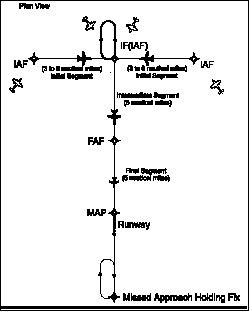
FIG
5-4-2
Basic "T" Design
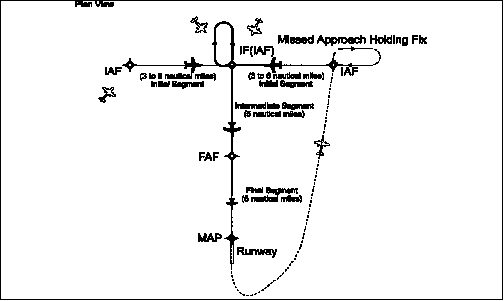
FIG
5-4-3
Modified Basic "T"
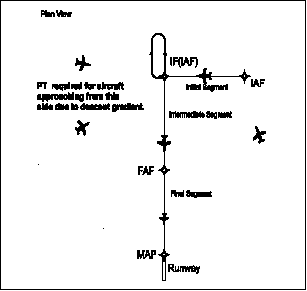
FIG
5-4-4
Modified "T" Approach to Parallel
Runways
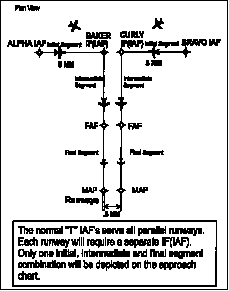
FIG
5-4-5
"T" Approach with Common IAFs to Parallel
Runways
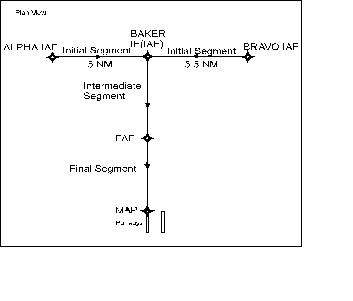
FIG
5-4-6
"T" Approach with Common IAFs to Parallel
Runways
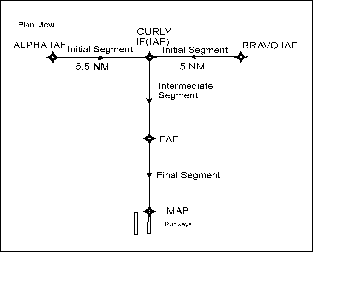
FIG
5-4-7
TAA Area
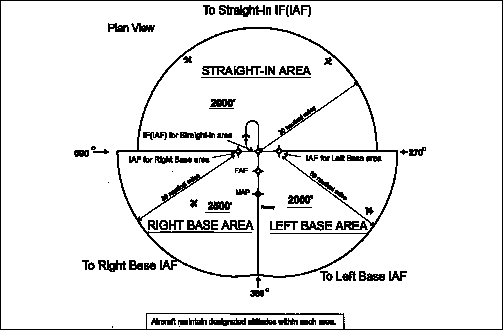
5. The
standard TAA consists of three areas defined by the
extension of the IAF legs and the intermediate segment
course. These areas are called the straight-in, left-base,
and right-base areas. (See FIG
5-4-7). TAA area lateral
boundaries are identified by magnetic courses TO the IF
(IAF). The straight-in area can be further divided into
pie-shaped sectors with the boundaries identified by
magnetic courses TO the IF (IAF), and may contain stepdown
sections defined by arcs based on RNAV distances (DME or
ATD) from the IF (IAF). The right/left-base areas can only
be subdivided using arcs based on RNAV distances from the
IAFs for those areas. Minimum MSL altitudes are charted
within each of these defined areas/subdivisions that provide
at least 1,000 feet of obstacle clearance, or more as
necessary in mountainous areas.
(a) Prior to
arriving at the TAA boundary, the pilot can determine which
area of the TAA the aircraft will enter by selecting the IF
(IAF) to determine the magnetic bearing TO the center IF
(IAF). That bearing should then be compared with the
published bearings that define the lateral boundaries of the
TAA areas. Using the end IAFs may give a false indication of
which area the aircraft will enter. This is critical when
approaching the TAA near the extended boundary between the
left and right-base areas, especially where these areas
contain different minimum altitude requirements.
(b) Pilots
entering the TAA and cleared by air traffic control, are
expected to proceed directly to the IAF associated with that
area of the TAA at the altitude depicted, unless otherwise
cleared by air traffic control. Cleared direct to an Initial
Approach Fix (IAF) without a clearance for the procedure
does not authorize a pilot to descend to a lower TAA
altitude. If a pilot desires a lower altitude without an
approach clearance, request the lower TAA altitude. If a
pilot is not sure of what they are authorized or expected to
do by air traffic, they should ask air traffic or request a
specific clearance. Pilots entering the TAA with two-way
radio communications failure (14 CFR Section 91.185,
IFR Operations: Two-way Radio Communications Failure), must
maintain the highest altitude prescribed by Section 91.185(c)(2)
until arriving at the appropriate IAF.
FIG
5-4-8
Sectored TAA Areas
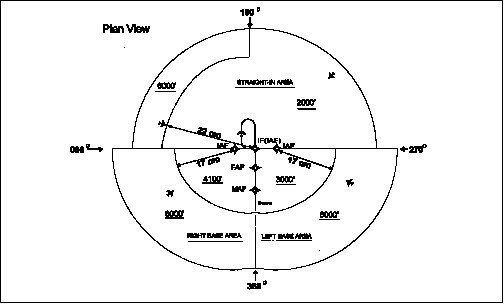
(c) Depiction
of the TAA on U.S. Government charts will be through the use
of icons located in the plan view outside the depiction of
the actual approach procedure. (See FIG
5-4-9). Use of icons is
necessary to avoid obscuring any portion of the "T"
procedure (altitudes, courses, minimum altitudes, etc.). The
icon for each TAA area will be located and oriented on the
plan view with respect to the direction of arrival to the
approach procedure, and will show all TAA minimum altitudes
and sector/radius subdivisions for that area. The IAF for
each area of the TAA is included on the icon where it
appears on the approach, to help the pilot orient the icon
to the approach procedure. The IAF name and the distance of
the TAA area boundary from the IAF are included on the
outside arc of the TAA area icon. Examples here are shown
with the TAA around the approach to aid pilots in
visualizing how the TAA corresponds to the approach and
should not be confused with the actual approach chart
depiction.
(d) Each
waypoint on the "T", except the missed approach waypoint, is
assigned a pronounceable 5-character name used in air
traffic control communications, and which is found in the
RNAV databases for the procedure. The missed approach
waypoint is assigned a pronounceable name when it is not
located at the runway threshold.
6. Once
cleared to fly the TAA, pilots are expected to obey minimum
altitudes depicted within the TAA icons, unless instructed
otherwise by air traffic control. In FIG
5-4-8, pilots within the left
or right-base areas are expected to maintain a minimum
altitude of 6,000 feet until within 17 NM of the associated
IAF. After crossing the 17 NM arc, descent is authorized to
the lower charted altitudes. Pilots approaching from the
northwest are expected to maintain a minimum altitude of
6,000 feet, and when within 22 NM of the IF (IAF), descend
to a minimum altitude of 2,000 feet MSL until reaching the
IF (IAF).
FIG
5-4-9
RNAV (GPS) Approach Chart
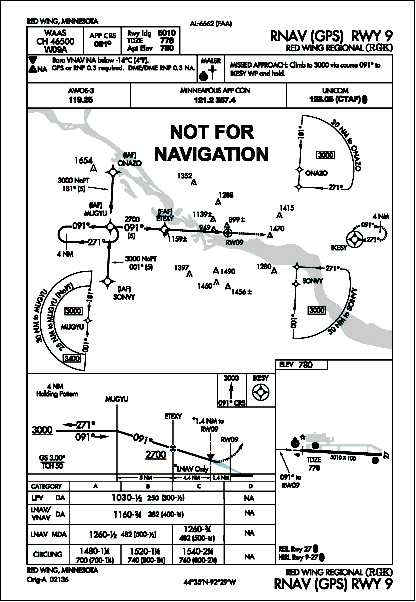
NOTE-
This chart has been modified to depict new concepts and may
not reflect actual approach minima.
FIG
5-4-10
TAA with Left and Right Base Areas
Eliminated
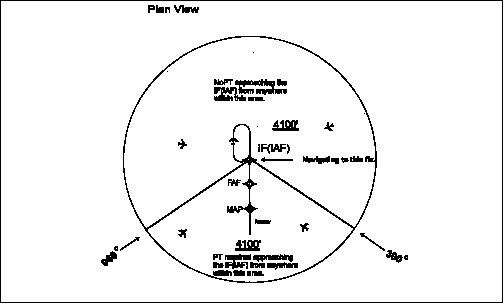
7. Just as the
underlying "T" approach procedure may be modified in shape,
the TAA may contain modifications to the defined area shapes
and sizes. Some areas may even be eliminated, with other
areas expanded as needed. FIG
5-4-10 is an example of a
design limitation where a course reversal is necessary when
approaching the IF (IAF) from certain directions due to the
amount of turn required at the IF (IAF). Design criteria
require a course reversal whenever this turn exceeds 120
degrees. In this generalized example, pilots approaching on
a bearing TO the IF (IAF) from 300° clockwise through
060° are expected to execute a course reversal. The
term "NoPT" will be annotated on the boundary of the TAA
icon for the other portion of the TAA.
FIG
5-4-11
TAA with Right Base Eliminated
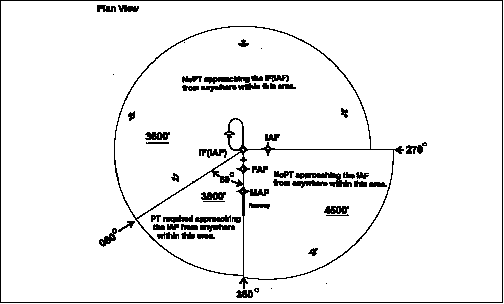
8.
FIG
5-4-11 depicts another TAA
modification that pilots may encounter. In this generalized
example, the right-base area has been eliminated. Pilots
operating within the TAA between 360°clockwise to
060° bearing TO the IF (IAF) are expected to execute
the course reversal in order to properly align the aircraft
for entry onto the intermediate segment. Aircraft operating
in all other areas from 060° clockwise to 360°
bearing TO the IF (IAF) need not perform the course
reversal, and the term "NoPT" will be annotated on the TAA
boundary of the icon in these areas. TAAs are no longer
being produced with sections removed; however, some may
still exist on previously published procedures.
FIG
5-4-12
Examples of a TAA with Feeders from an
Airway
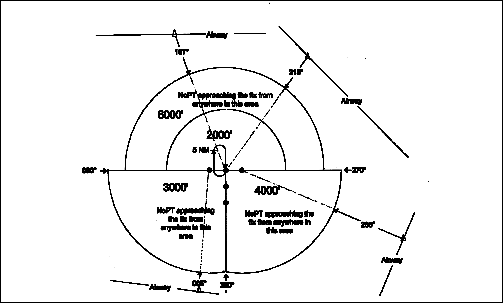
9. When an
airway does not cross the lateral TAA boundaries, a feeder
route will be established to provide a transition from the
en route structure to the appropriate IAF. Each feeder route
will terminate at the TAA boundary, and will be aligned
along a path pointing to the associated IAF. Pilots should
descend to the TAA altitude after crossing the TAA boundary
and cleared by air traffic control. (See FIG
5-4-12).
FIG
5-4-13
Minimum Vectoring Altitude Charts
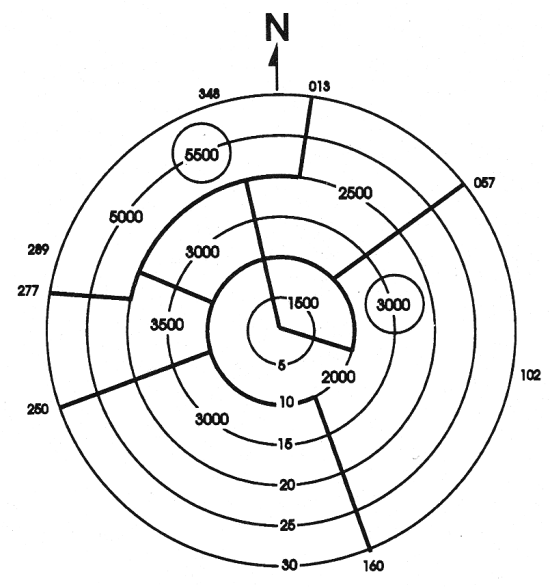
e. Minimum
Vectoring Altitudes (MVAs) are established for use by
ATC when radar ATC is exercised. MVA charts are prepared by
air traffic facilities at locations where there are numerous
different minimum IFR altitudes. Each MVA chart has sectors
large enough to accommodate vectoring of aircraft within the
sector at the MVA. Each sector boundary is at least 3 miles
from the obstruction determining the MVA. To avoid a large
sector with an excessively high MVA due to an isolated
prominent obstruction, the obstruction may be enclosed in a
buffer area whose boundaries are at least 3 miles from the
obstruction. This is done to facilitate vectoring around the
obstruction. (See FIG
5-4-13.)
1. The minimum
vectoring altitude in each sector provides 1,000 feet above
the highest obstacle in nonmountainous areas and 2,000 feet
above the highest obstacle in designated mountainous areas.
Where lower MVAs are required in designated mountainous
areas to achieve compatibility with terminal routes or to
permit vectoring to an IAP, 1,000 feet of obstacle
clearance may be authorized with the use of Airport
Surveillance Radar (ASR). The minimum vectoring altitude
will provide at least 300 feet above the floor of controlled
airspace.
NOTE-
OROCA is an off-route altitude which provides obstruction
clearance with a 1,000 foot buffer in nonmountainous terrain
areas and a 2,000 foot buffer in designated mountainous
areas within the U.S. This altitude may not provide signal
coverage from ground-based navigational aids, air traffic
control radar, or communications coverage.
2. Because of
differences in the areas considered for MVA, and those
applied to other minimum altitudes, and the ability to
isolate specific obstacles, some MVAs may be lower than the
nonradar Minimum En Route Altitudes (MEAs), Minimum
Obstruction Clearance Altitudes (MOCAs) or other minimum
altitudes depicted on charts for a given location. While
being radar vectored, IFR altitude assignments by ATC will
be at or above MVA.
f. Visual Descent
Points (VDPs) are being incorporated in nonprecision
approach procedures. The VDP is a defined point on the final
approach course of a nonprecision straight-in approach
procedure from which normal descent from the MDA to the
runway touchdown point may be commenced, provided visual
reference required by 14 CFR Section 91.175(c)(3) is
established. The VDP will normally be identified by DME on
VOR and LOC procedures and by along-track distance to the
next waypoint for RNAV procedures. The VDP is identified on
the profile view of the approach chart by the symbol:
V.
1.
VDPs are intended to provide additional guidance where
they are implemented. No special technique is required to
fly a procedure with a VDP. The pilot should not descend
below the MDA prior to reaching the VDP and acquiring the
necessary visual reference.
2. Pilots not
equipped to receive the VDP should fly the approach
procedure as though no VDP had been provided.
g. Visual Portion
of the Final Segment. Instrument procedures designers
perform a visual area obstruction evaluation off the
approach end of each runway authorized for instrument
landing, straight-in, or circling. Restrictions to
instrument operations are imposed if penetrations of the
obstruction clearance surfaces exist. These restrictions
vary based on the severity of the penetrations, and may
include increasing required visibility, denying VDPs and
prohibiting night instrument operations to the runway.
h. Charting of
Close in Obstacles on Instrument Procedure Charts.
Obstacles that are close to the airport may be depicted in
either the planview of the instrument approach chart or the
airport sketch. Obstacles are charted in only one of the
areas, based on space available and distance from the
runway. These obstacles could be in the visual segment of
the instrument approach procedure. On nonprecision
approaches, these obstacles should be considered when
determining where to begin descent from the MDA (see "Pilot
Operational Considerations When Flying Nonprecision
Approaches" in this paragraph).
i.
Vertical Descent Angle (VDA) on Nonprecision Approaches.
FAA policy is to publish VDAs on all nonprecision
approaches. Published along with VDA is the threshold
crossing height (TCH) that was used to compute the angle.
The descent angle may be computed from either the final
approach fix (FAF), or a stepdown fix, to the runway
threshold at the published TCH. A stepdown fix is only used
as the start point when an angle computed from the FAF would
place the aircraft below the stepdown fix altitude. The
descent angle and TCH information are charted on the profile
view of the instrument approach chart following the fix the
angle was based on. The optimum descent angle is 3.00
degrees; and whenever possible the approach will be designed
using this angle.
1. The VDA
provides the pilot with information not previously available
on nonprecision approaches. It provides a means for the
pilot to establish a stabilized descent from the FAF or
stepdown fix to the MDA. Stabilized descent is a key factor
in the reduction of controlled flight into terrain (CFIT)
incidents. However, pilots should be aware that the
published angle is for information only - it is strictly
advisory in nature. There is no implicit additional obstacle
protection below the MDA. Pilots must still respect the
published minimum descent altitude (MDA) unless the visual
cues stated 14 CFR Section 91.175 are present and they can
visually acquire and avoid obstacles once below the MDA. The
presence of a VDA does not guarantee obstacle protection in
the visual segment and does not change any of the
requirements for flying a nonprecision approach.
2. Additional
protection for the visual segment below the MDA is provided
if a VDP is published and descent below the MDA is started
at or after the VDP. Protection is also provided, if a
Visual Glide Slope Indicator (VGSI); e.g., VASI or PAPI, is
installed and the aircraft remains on the VGSI glide path
angle from the MDA. In either case, a chart note will
indicate if the VDP or VGSI are not coincident with the VDA.
On RNAV approach charts, a small shaded arrowhead shaped
symbol (see the legend of the U.S. Terminal Procedures
books, page H1) from the end of the VDA to the runway
indicates that the 34:1 visual surface is clear.
3. Pilots may
use the published angle and estimated/actual groundspeed to
find a target rate of descent from the rate of descent table
published in the back of the U.S. Terminal Procedures
Publication. This rate of descent can be flown with the
Vertical Velocity Indicator (VVI) in order to use the VDA as
an aid to flying a stabilized descent. No special equipment
is required.
j. Pilot
Operational Considerations When Flying Nonprecision
Approaches. The missed approach point (MAP) on a
nonprecision approach is not designed with any
consideration to where the aircraft must begin descent
to execute a safe landing. It is developed based on terrain,
obstructions, NAVAID location and possibly air traffic
considerations. Because the MAP may be located anywhere from
well prior to the runway threshold to past the opposite end
of the runway, the descent from the Minimum Descent Altitude
(MDA) to the runway threshold cannot be determined based on
the MAP location. Descent from MDA at the MAP when the MAP
is located close to the threshold would require an
excessively steep descent gradient to land in the normal
touchdown zone. Any turn from the final approach course to
the runway heading may also be a factor in when to begin the
descent.
1.
Pilots are cautioned that descent to a straight-in
landing from the MDA at the MAP may be inadvisable or
impossible, on a nonprecision approach, even if current
weather conditions meet the published ceiling and
visibility. Aircraft speed, height above the runway, descent
rate, amount of turn and runway length are some of the
factors which must be considered by the pilot to determine
if a landing can be accomplished.
2. Visual
descent points (VDPs) provide pilots with a reference for
the optimal location to begin descent from the MDA, based on
the designed vertical descent angle (VDA) for the approach
procedure, assuming required visual references are
available. Approaches without VDPs have not been assessed
for terrain clearance below the MDA, and may not provide a
clear vertical path to the runway at the normally expected
descent angle. Therefore, pilots must be especially vigilant
when descending below the MDA at locations without VDPs.
This does not necessarily prevent flying the normal angle;
it only means that obstacle clearance in the visual segment
could be less and greater care should be exercised in
looking for obstacles in the visual segment. Use of visual
glide slope indicator (VGSI) systems can aid the pilot in
determining if the aircraft is in a position to make the
descent from the MDA. However, when the visibility is close
to minimums, the VGSI may not be visible at the start
descent point for a "normal" glidepath, due to its location
down the runway.
3.
Accordingly, pilots are advised to carefully review
approach procedures, prior to initiating the approach, to
identify the optimum position(s), and any unacceptable
positions, from which a descent to landing can be initiated
(in accordance with 14 CFR Section 91.175(c)).
k.
Area Navigation (RNAV) Instrument Approach Charts.
Reliance on RNAV systems for instrument operations is
becoming more commonplace as new systems such as GPS and
augmented GPS such as the Wide Area Augmentation System
(WAAS) are developed and deployed. In order to support full
integration of RNAV procedures into the National Airspace
System (NAS), the FAA developed a new charting format for
IAPs (See FIG 5-4-9). This format avoids unnecessary
duplication and proliferation of instrument approach charts.
The original stand alone GPS charts, titled simply "GPS,"
are being converted to the newer format as the procedures
are revised. One reason for the revision could be the
addition of WAAS based minima to the approach chart. The
reformatted approach chart is titled "RNAV (GPS) RWY XX." Up
to four lines of minima are included on these charts. GLS
(Global Navigation Satellite System [GNSS] Landing
System) was a placeholder for future WAAS and LAAS minima,
and the minima was always listed as N/A. The GLS minima line
has now been replaced by the WAAS LPV (Localizer Performance
with Vertical Guidance) minima on most RNAV (GPS) charts.
LNAV/VNAV (lateral navigation/vertical navigation) was added
to support both WAAS electronic vertical guidance and
Barometric VNAV. LPV and LNAV/VNAV are both APV procedures
as described in paragraph 5-4-5a7.
The original GPS minima, titled "S-XX," for straight in
runway XX, is retitled LNAV (lateral navigation). Circling
minima may also be published. A new type of nonprecision
WAAS minima will also be published on this chart and titled
LP (localizer performance). LP will be published in
locations where vertically guided minima cannot be provided
due to terrain and obstacles and therefore, no LPV or
LNAV/VNAV minima will be published. Current plans call for
LAAS based procedures to be published on a separate chart
and for the GLS minima line to be used only for LAAS. ATC
clearance for the RNAV procedure authorizes a properly
certified pilot to utilize any minimums for which the
aircraft is certified: e.g. a WAAS equipped aircraft utilize
the LPV or LP minima but a GPS only aircraft may not. The
RNAV chart includes information formatted for quick
reference by the pilot or flight crew at the top of the
chart. This portion of the chart, developed based on a study
by the Department of Transportation, Volpe National
Transportation System Center, is commonly referred to as the
pilot briefing.
1.
The minima lines are:
(a) GLS. "GLS"
is the acronym for GNSS landing system; GNSS is the ICAO
acronym for Global Navigation Satellite System (the
international term for all GPS type systems). This line was
originally published as a placeholder for both WAAS and LAAS
minima and marked as N/A since no minima was published. As
the concepts for LAAS and WAAS procedure publication have
evolved, GLS will now be used only for LAAS minima, which
will be on a separate approach chart. Most RNAV(GPS)
approach charts have had the GLS minima line replaced by a
WAAS LPV line of minima.
(b) LPV. "LPV"
is the acronym for localizer performance with vertical
guidance. LPV identifies WAAS APV approach minimums with
electronic lateral and vertical guidance. The lateral
guidance is equivalent to localizer and the protected area
for LPV procedures is now the same as for an ILS. The
obstacle clearance area is considerably smaller than the
LNAV/VNAV protection, allowing lower minima in many cases.
Aircraft can fly this minima line with a statement in the
Aircraft Flight Manual that the installed equipment supports
LPV approaches. This includes Class 3 and 4 TSO-C146 WAAS
equipment.
(c) LNAV/VNAV.
LNAV/VNAV identifies APV minimums developed to accommodate
an RNAV IAP with vertical guidance, usually provided by
approach certified Baro-VNAV, but with lateral and vertical
integrity limits larger than a precision approach or LPV.
LNAV stands for Lateral Navigation; VNAV stands for Vertical
Navigation. This minima line can be flown by aircraft with a
statement in the Aircraft Flight Manual that the installed
equipment supports GPS approaches and has an
approach-approved barometric VNAV, or if the aircraft has
been demonstrated to support LNAV/VNAV approaches. This
includes Class 2, 3 and 4 TSO-C146 WAAS equipment. Aircraft
using LNAV/VNAV minimums will descend to landing via an
internally generated descent path based on satellite or
other approach approved VNAV systems. WAAS equipment may
revert to this mode of operation when the signal does not
support LPV integrity. Since electronic vertical guidance is
provided, the minima will be published as a DA. Other
navigation systems may be specifically authorized to use
this line of minima, see Section A, Terms/Landing Minima
Data, of the U.S. Terminal Procedures books.
(d) LP. "LP"
is the acronym for localizer performance. LP identifies
nonprecision WAAS minimums which are equivalent to ILS
Localizer. LP is intended for use in locations where
vertical guidance cannot be provided. The protected area is
considerably smaller than the area for the present LNAV
lateral protection and will provide a lower MDA in many
cases. WAAS equipment capable of LPV also supports LP
operations. LPV and LP cannot be published as part of the
same instrument procedure due to equipment limitations.
(e) LNAV. This
minima is for lateral navigation only, and the approach
minimum altitude will be published as a minimum descent
altitude (MDA). LNAV provides the same level of service as
the present GPS stand alone approaches. LNAV minimums
support the following navigation systems: WAAS, when the
navigation solution will not support vertical navigation;
and, GPS navigation systems which are presently authorized
to conduct GPS approaches. Existing GPS approaches continue
to be converted to the RNAV (GPS) format as they are revised
or reviewed.
NOTE-
GPS receivers approved for approach operations in accordance
with: AC 20-138, Airworthiness Approval of Global
Positioning System (GPS) Navigation Equipment for Use as a
VFR and IFR Supplemental Navigation System, for stand-alone
Technical Standard Order (TSO) TSO-C129 Class A(1) systems;
or AC 20-130A, Airworthiness Approval of Navigation or
Flight Management Systems Integrating Multiple Navigation
Sensors, for GPS as part of a multi-sensor system, qualify
for this minima. WAAS navigation equipment must be approved
in accordance with the requirements specified in TSO-C145 or
TSO-C146 and installed in accordance with Advisory Circular
AC 20-138A, Airworthiness Approval of Global Navigation
Satellite System (GNSS) Equipment.
2. Other
systems may be authorized to utilize these approaches. See
the description in Section A of the U.S. Terminal Procedures
books for details. These systems may include aircraft
equipped with an FMS that can file /E or /F. Operational
approval must also be obtained for Baro-VNAV systems to
operate to the LNAV/VNAV minimums. Baro-VNAV may not be
authorized on some approaches due to other factors, such as
no local altimeter source being available. Baro-VNAV is not
authorized on LPV procedures. Pilots are directed to their
local Flight Standards District Office (FSDO) for additional
information.
NOTE-
RNAV and Baro-VNAV systems must have a manufacturer supplied
electronic database which shall include the waypoints,
altitudes, and vertical data for the procedure to be flown.
The system shall also be able to extract the procedure in
its entirety, not just as a manually entered series of
waypoints.
3. Required
Navigation Performance (RNP)
(a) Pilots are
advised to refer to the "TERMS/LANDING MINIMUMS DATA"
(Section A) of the U.S. Government Terminal Procedures
books for aircraft approach eligibility requirements by
specific RNP level requirements.
(b) Some
aircraft have RNP approval in their AFM without a GPS
sensor. The lowest level of sensors that the FAA will
support for RNP service is DME/DME. However, necessary DME
signal may not be available at the airport of intended
operations. For those locations having an RNAV chart
published with LNAV/VNAV minimums, a procedure note may be
provided such as "DME/DME RNP-0.3 NA." This means that RNP
aircraft dependent on DME/DME to achieve RNP-0.3 are not
authorized to conduct this approach. Where DME facility
availability is a factor, the note may read "DME/DME RNP-0.3
Authorized; ABC and XYZ Required." This means that ABC and
XYZ facilities have been determined by flight inspection to
be required in the navigation solution to assure RNP-0.3.
VOR/DME updating must not be used for approach procedures.
4. Chart
Terminology
(a) Decision
Altitude (DA) replaces the familiar term Decision Height
(DH). DA conforms to the international convention where
altitudes relate to MSL and heights relate to AGL. DA will
eventually be published for other types of instrument
approach procedures with vertical guidance, as well. DA
indicates to the pilot that the published descent profile is
flown to the DA (MSL), where a missed approach will be
initiated if visual references for landing are not
established. Obstacle clearance is provided to allow a
momentary descent below DA while transitioning from the
final approach to the missed approach. The aircraft is
expected to follow the missed instructions while continuing
along the published final approach course to at least the
published runway threshold waypoint or MAP (if not at the
threshold) before executing any turns.
(b) Minimum
Descent Altitude (MDA) has been in use for many years, and
will continue to be used for the LNAV only and circling
procedures.
(c) Threshold
Crossing Height (TCH) has been traditionally used in
"precision" approaches as the height of the glide slope
above threshold. With publication of LNAV/VNAV minimums and
RNAV descent angles, including graphically depicted descent
profiles, TCH also applies to the height of the "descent
angle," or glidepath, at the threshold. Unless otherwise
required for larger type aircraft which may be using the
IAP, the typical TCH is 30 to 50 feet.
5. The
MINIMA FORMAT will also change slightly.
(a) Each line
of minima on the RNAV IAP is titled to reflect the level of
service available; e.g., GLS, LPV, LNAV/VNAV, and LNAV.
CIRCLING minima will also be provided.
(b) The minima
title box indicates the nature of the minimum altitude for
the IAP. For example:
(1) DA
will be published next to the minima line title for
minimums supporting vertical guidance such as for GLS, LPV
or LNAV/VNAV.
(2) MDA will
be published where the minima line was designed to support
aircraft with only lateral guidance available, such as LNAV.
Descent below the MDA, including during the missed approach,
is not authorized unless the visual conditions stated in 14 CFR
Section 91.175 exist.
(3) Where two
or more systems, such as LPV and LNAV/VNAV, share the same
minima, each line of minima will be displayed separately.
6. Chart
Symbology changed slightly to include:
(a) Descent
Profile. The published descent profile and a graphical
depiction of the vertical path to the runway will be shown.
Graphical depiction of the RNAV vertical guidance will
differ from the traditional depiction of an ILS glide slope
(feather) through the use of a shorter vertical track
beginning at the decision altitude.
(1) It is FAA
policy to design IAPs with minimum altitudes established at
fixes/waypoints to achieve optimum stabilized (constant
rate) descents within each procedure segment. This design
can enhance the safety of the operations and contribute
toward reduction in the occurrence of controlled flight into
terrain (CFIT) accidents. Additionally, the National
Transportation Safety Board (NTSB) recently emphasized that
pilots could benefit from publication of the appropriate IAP
descent angle for a stabilized descent on final approach.
The RNAV IAP format includes the descent angle to the
hundredth of a degree; e.g., 3.00 degrees. The angle
will be provided in the graphically depicted descent
profile.
(2)
The stabilized approach may be performed by reference to
vertical navigation information provided by WAAS or
LNAV/VNAV systems; or for LNAV-only systems, by the pilot
determining the appropriate aircraft attitude/groundspeed
combination to attain a constant rate descent which best
emulates the published angle. To aid the pilot, U.S.
Government Terminal Procedures Publication charts publish an
expanded Rate of Descent Table on the inside of the back
hard cover for use in planning and executing precision
descents under known or approximate groundspeed conditions.
(b) Visual Descent
Point (VDP). A VDP will be published on most RNAV IAPs.
VDPs apply only to aircraft utilizing LNAV minima, not LPV
or LNAV/VNAV minimums.
(c) Missed
Approach Symbology. In order to make missed approach
guidance more readily understood, a method has been
developed to display missed approach guidance in the profile
view through the use of quick reference icons. Due to
limited space in the profile area, only four or fewer icons
can be shown. However, the icons may not provide
representation of the entire missed approach procedure. The
entire set of textual missed approach instructions are
provided at the top of the approach chart in the pilot
briefing. (See FIG
5-4-9).
(d) Waypoints.
All RNAV or GPS stand-alone IAPs are flown using data
pertaining to the particular IAP obtained from an onboard
database, including the sequence of all WPs used for the
approach and missed approach, except that step down
waypoints may not be included in some TSO-C129 receiver
databases. Included in the database, in most receivers, is
coding that informs the navigation system of which WPs are
fly-over (FO) or fly-by (FB). The navigation system may
provide guidance appropriately - including leading the turn
prior to a fly-by WP; or causing overflight of a fly-over
WP. Where the navigation system does not provide such
guidance, the pilot must accomplish the turn lead or
waypoint overflight manually. Chart symbology for the FB WP
provides pilot awareness of expected actions. Refer to the
legend of the U.S. Terminal Procedures books.
(e) TAAs are
described in paragraph 5-4-5d,
Terminal Arrival Area (TAA). When published, the RNAV chart
depicts the TAA areas through the use of "icons"
representing each TAA area associated with the RNAV
procedure (See FIG
5-4-9). These icons are
depicted in the plan view of the approach chart, generally
arranged on the chart in accordance with their position
relative to the aircraft's arrival from the en route
structure. The WP, to which navigation is appropriate and
expected within each specific TAA area, will be named and
depicted on the associated TAA icon. Each depicted named WP
is the IAF for arrivals from within that area. TAAs may not
be used on all RNAV procedures because of airspace
congestion or other reasons.
(f) Cold
Temperature Limitations. A minimum temperature
limitation is published on procedures which authorize
Baro-VNAV operation. This temperature represents the airport
temperature below which use of the Baro-VNAV is not
authorized to the LNAV/VNAV minimums. An example limitation
will read: "Baro-VNAV NA below
-20°C(-4°F)." This information will be found
in the upper left hand box of the pilot briefing.
NOTE-
Temperature limitations do not apply to flying the LNAV/VNAV
line of minima using approach certified WAAS receivers.
(g) WAAS Channel
Number/Approach ID. The WAAS Channel Number is an
equipment optional capability that allows the use of a
5-digit number to select a specific final approach segment.
The Approach ID is an airport unique 4-letter combination
for verifying selection of the correct final approach
segment, e.g., W-35L, where W stands for WAAS and 35L is
runway 35 left. The WAAS Channel Number and Approach ID will
be displayed in the upper left corner of the approach
procedure pilot briefing.
(h) At
locations where outages of WAAS vertical guidance may occur
daily due to initial system limitations, a negative W symbol
( )
will be placed on RNAV (GPS) approach charts. Many of these
outages will be very short in duration, but may result in
the disruption of the vertical portion of the approach. The )
will be placed on RNAV (GPS) approach charts. Many of these
outages will be very short in duration, but may result in
the disruption of the vertical portion of the approach. The
 symbol indicates that NOTAMs or Air Traffic advisories are
not provided for outages which occur in the WAAS LNAV/VNAV
or LPV vertical service. Use LNAV minima for flight planning
at these locations, whether as a destination or alternate.
For flight operations at these locations, when the WAAS
avionics indicate that LNAV/VNAV or LPV service is
available, then vertical guidance may be used to complete
the approach using the displayed level of service. Should an
outage occur during the procedure, reversion to LNAV minima
may be required. As the WAAS coverage is expanded, the
symbol indicates that NOTAMs or Air Traffic advisories are
not provided for outages which occur in the WAAS LNAV/VNAV
or LPV vertical service. Use LNAV minima for flight planning
at these locations, whether as a destination or alternate.
For flight operations at these locations, when the WAAS
avionics indicate that LNAV/VNAV or LPV service is
available, then vertical guidance may be used to complete
the approach using the displayed level of service. Should an
outage occur during the procedure, reversion to LNAV minima
may be required. As the WAAS coverage is expanded, the
 will be removed.
will be removed.
5-4-6.
Approach Clearance
a. An aircraft
which has been cleared to a holding fix and subsequently
"cleared . . . approach" has not received new routing. Even
though clearance for the approach may have been issued prior
to the aircraft reaching the holding fix, ATC would expect
the pilot to proceed via the holding fix (his/her last
assigned route), and the feeder route associated with that
fix (if a feeder route is published on the approach chart)
to the initial approach fix (IAF) to commence the approach.
WHEN CLEARED FOR THE APPROACH, THE PUBLISHED OFF AIRWAY
(FEEDER) ROUTES THAT LEAD FROM THE EN ROUTE STRUCTURE
TO THE IAF ARE PART OF THE APPROACH CLEARANCE.
b. If a feeder
route to an IAF begins at a fix located along the route of
flight prior to reaching the holding fix, and clearance for
an approach is issued, a pilot should commence the approach
via the published feeder route; i.e., the aircraft would not
be expected to overfly the feeder route and return to it.
The pilot is expected to commence the approach in a similar
manner at the IAF, if the IAF for the procedure is located
along the route of flight to the holding fix.
c. If a route
of flight directly to the initial approach fix is desired,
it should be so stated by the controller with phraseology to
include the words "direct . . . ," "proceed direct" or a
similar phrase which the pilot can interpret without
question. When uncertain of the clearance, immediately query
ATC as to what route of flight is desired.
d. The name of
an instrument approach, as published, is used to identify
the approach, even though a component of the approach aid,
such as the glideslope on an Instrument Landing System, is
inoperative or unreliable. The controller will use the name
of the approach as published, but must advise the aircraft
at the time an approach clearance is issued that the
inoperative or unreliable approach aid component is
unusable.
5-4-7.
Instrument Approach Procedures
a. Aircraft
approach category means a grouping of aircraft based on a
speed of VREF, if specified, or if
VREF is not specified, 1.3 VSO at the
maximum certified landing weight. VREF,
VSO, and the maximum certified landing weight are
those values as established for the aircraft by the
certification authority of the country of registry. A pilot
must use the minima corresponding to the category determined
during certification or higher. Helicopters may use Category
A minima. If it is necessary to operate at a speed in excess
of the upper limit of the speed range for an aircraft's
category, the minimums for the higher category must be used.
For example, an airplane which fits into Category B, but is
circling to land at a speed of 145 knots, must use the
approach Category D minimums. As an additional example, a
Category A airplane (or helicopter) which is operating at
130 knots on a straight-in approach must use the approach
Category C minimums. See the following category limits:
1. Category A:
Speed less than 91 knots.
2. Category B:
Speed 91 knots or more but less than 121 knots.
3. Category C:
Speed 121 knots or more but less than 141 knots.
4. Category D:
Speed 141 knots or more but less than 166 knots.
5. Category E:
Speed 166 knots or more.
NOTE-
VREF in the above definition refers to the speed
used in establishing the approved landing distance under the
airworthiness regulations constituting the type
certification basis of the airplane, regardless of whether
that speed for a particular airplane is 1.3 VSO,
1.23 VSR, or some higher speed required for
airplane controllability. This speed, at the maximum
certificated landing weight, determines the lowest
applicable approach category for all approaches regardless
of actual landing weight.
b.
When operating on an unpublished route or while being
radar vectored, the pilot, when an approach clearance is
received, shall, in addition to complying with the minimum
altitudes for IFR operations (14 CFR Section 91.177),
maintain the last assigned altitude unless a different
altitude is assigned by ATC, or until the aircraft is
established on a segment of a published route or IAP. After
the aircraft is so established, published altitudes apply to
descent within each succeeding route or approach segment
unless a different altitude is assigned by ATC.
Notwithstanding this pilot responsibility, for aircraft
operating on unpublished routes or while being radar
vectored, ATC will, except when conducting a radar approach,
issue an IFR approach clearance only after the aircraft is
established on a segment of a published route or IAP, or
assign an altitude to maintain until the aircraft is
established on a segment of a published route or instrument
approach procedure. For this purpose, the procedure turn of
a published IAP shall not be considered a segment of that
IAP until the aircraft reaches the initial fix or navigation
facility upon which the procedure turn is predicated.
EXAMPLE-
Cross Redding VOR at or above five thousand, cleared VOR
runway three four approach.
or
Five miles from outer marker, turn right heading three three
zero, maintain two thousand until established on the
localizer, cleared ILS runway three six approach.
NOTE-
The altitude assigned will assure IFR obstruction clearance
from the point at which the approach clearance is issued
until established on a segment of a published route or IAP.
If uncertain of the meaning of the clearance, immediately
request clarification from ATC.
c. Several
IAPs, using various navigation and approach aids may be
authorized for an airport. ATC may advise that a particular
approach procedure is being used, primarily to expedite
traffic. If issued a clearance that specifies a particular
approach procedure, notify ATC immediately if a different
one is desired. In this event it may be necessary for ATC to
withhold clearance for the different approach until such
time as traffic conditions permit. However, a pilot involved
in an emergency situation will be given priority. If the
pilot is not familiar with the specific approach procedure,
ATC should be advised and they will provide detailed
information on the execution of the procedure.
REFERENCE-
AIM, Advance Information on Instrument Approach, Paragraph
5-4-4.
d. At times
ATC may not specify a particular approach procedure in the
clearance, but will state "CLEARED APPROACH." Such clearance
indicates that the pilot may execute any one of the
authorized IAPs for that airport. This clearance does not
constitute approval for the pilot to execute a contact
approach or a visual approach.
e. Except when
being radar vectored to the final approach course, when
cleared for a specifically prescribed IAP; i.e., "cleared
ILS runway one niner approach" or when "cleared approach"
i.e., execution of any procedure prescribed for the airport,
pilots shall execute the entire procedure commencing at an
IAF or an associated feeder route as described on the IAP
chart unless an appropriate new or revised ATC clearance is
received, or the IFR flight plan is canceled.
f.
Pilots planning flights to locations which are private
airfields or which have instrument approach procedures based
on private navigation aids should obtain approval from the
owner. In addition, the pilot must be authorized by the FAA
to fly special instrument approach procedures associated
with private navigation aids (see paragraph 5-4-8).
Owners of navigation aids that are not for public use may
elect to turn off the signal for whatever reason they may
have; e.g., maintenance, energy conservation, etc. Air
traffic controllers are not required to question pilots to
determine if they have permission to land at a private
airfield or to use procedures based on privately owned
navigation aids, and they may not know the status of the
navigation aid. Controllers presume a pilot has obtained
approval from the owner and the FAA for use of special
instrument approach procedures and is aware of any details
of the procedure if an IFR flight plan was filed to that
airport.
g. Pilots
should not rely on radar to identify a fix unless the fix is
indicated as "RADAR" on the IAP. Pilots may request radar
identification of an OM, but the controller may not be able
to provide the service due either to workload or not having
the fix on the video map.
h.
If a missed approach is required, advise ATC and include
the reason (unless initiated by ATC). Comply with the missed
approach instructions for the instrument approach procedure
being executed, unless otherwise directed by ATC.
REFERENCE-
AIM, Missed Approach, Paragraph 5-4-21.
AIM, Missed Approach, Paragraph 5-5-5.
i. ATC may
clear aircraft that have filed an Advanced RNAV equipment
suffix to the intermediate fix when clearing aircraft for an
instrument approach procedure. ATC will take the following
actions when clearing Advanced RNAV aircraft to the
intermediate fix:
1. Provide
radar monitoring to the intermediate fix.
2. Advise the
pilot to expect clearance direct to the intermediate fix at
least 5 miles from the fix.
NOTE-
This is to allow the pilot to program the RNAV equipment to
allow the aircraft to fly to the intermediate fix when
cleared by ATC.
3. Assign an
altitude to maintain until the intermediate fix.
4. Insure the
aircraft is on a course that will intercept the intermediate
segment at an angle not greater than 90 degrees and is at an
altitude that will permit normal descent from the
intermediate fix to the final approach fix.
5-4-8.
Special Instrument Approach Procedures
Instrument Approach
Procedure (IAP) charts reflect the criteria associated with
the U.S. Standard for Terminal Instrument [Approach]
Procedures (TERPs), which prescribes standardized methods
for use in developing IAPs. Standard IAPs are published in
the Federal Register (FR) in accordance with Title 14
of the Code of Federal Regulations, Part 97, and are
available for use by appropriately qualified pilots
operating properly equipped and airworthy aircraft in
accordance with operating rules and procedures acceptable to
the FAA. Special IAPs are also developed using TERPS but are
not given public notice in the FR. The FAA authorizes only
certain individual pilots and/or pilots in individual
organizations to use special IAPs, and may require
additional crew training and/or aircraft equipment or
performance, and may also require the use of landing aids,
communications, or weather services not available for public
use. Additionally, IAPs that service private use airports or
heliports are generally special IAPs.
5-4-9.
Procedure Turn
a. A procedure
turn is the maneuver prescribed when it is necessary to
reverse direction to establish the aircraft inbound on an
intermediate or final approach course. The procedure turn or
hold-in-lieu-of-PT is a required maneuver when it is
depicted on the approach chart. However, the procedure turn
or hold-in-lieu-of-PT is not permitted when the symbol "No
PT" is depicted on the initial segment being used, when a
RADAR VECTOR to the final approach course is provided, or
when conducting a timed approach from a holding fix. The
altitude prescribed for the procedure turn is a minimum
altitude until the aircraft is established on the inbound
course. The maneuver must be completed within the distance
specified in the profile view.
NOTE-
The pilot may elect to use the procedure turn or
hold-in-lieu-of-PT when it is not required by the procedure,
but must first receive an amended clearance from ATC. When
ATC is radar vectoring to the final approach course or to
the intermediate fix, ATC may specify in the approach
clearance "CLEARED STRAIGHT-IN (type) APPROACH" to ensure
the procedure turn or hold-in-lieu-of-PT is not to be flown.
If the pilot is uncertain whether the ATC clearance intends
for a procedure turn to be conducted or to allow for a
straight-in approach, the pilot shall immediately request
clarification from ATC (14 CFR Section 91.123).
1. On U.S.
Government charts, a barbed arrow indicates the direction or
side of the outbound course on which the procedure turn is
made. Headings are provided for course reversal using the 45
degree type procedure turn. However, the point at which the
turn may be commenced and the type and rate of turn is left
to the discretion of the pilot. Some of the options are the
45 degree procedure turn, the racetrack pattern, the
tear-drop procedure turn, or the 80 degree $ 260 degree
course reversal. Some procedure turns are specified by
procedural track. These turns must be flown exactly as
depicted.
2. When the
approach procedure involves a procedure turn, a maximum
speed of not greater than 200 knots (IAS) should be observed
from first overheading the course reversal IAF through the
procedure turn maneuver to ensure containment within the
obstruction clearance area. Pilots should begin the outbound
turn immediately after passing the procedure turn fix. The
procedure turn maneuver must be executed within the distance
specified in the profile view. The normal procedure turn
distance is 10 miles. This may be reduced to a minimum of 5 miles
where only Category A or helicopter aircraft are to be
operated or increased to as much as 15 miles to accommodate
high performance aircraft.
3.
A teardrop procedure or penetration turn may be
specified in some procedures for a required course reversal.
The teardrop procedure consists of departure from an initial
approach fix on an outbound course followed by a turn toward
and intercepting the inbound course at or prior to the
intermediate fix or point. Its purpose is to permit an
aircraft to reverse direction and lose considerable altitude
within reasonably limited airspace. Where no fix is
available to mark the beginning of the intermediate segment,
it shall be assumed to commence at a point 10 miles prior to
the final approach fix. When the facility is located on the
airport, an aircraft is considered to be on final approach
upon completion of the penetration turn. However, the final
approach segment begins on the final approach course 10
miles from the facility.
4. A holding
pattern in lieu of procedure turn may be specified for
course reversal in some procedures. In such cases, the
holding pattern is established over an intermediate fix or a
final approach fix. The holding pattern distance or time
specified in the profile view must be observed. Maximum
holding airspeed limitations as set forth for all holding
patterns apply. The holding pattern maneuver is completed
when the aircraft is established on the inbound course after
executing the appropriate entry. If cleared for the approach
prior to returning to the holding fix, and the aircraft is
at the prescribed altitude, additional circuits of the
holding pattern are not necessary nor expected by ATC. If
pilots elect to make additional circuits to lose excessive
altitude or to become better established on course, it is
their responsibility to so advise ATC upon receipt of their
approach clearance.
5. A procedure
turn is not required when an approach can be made directly
from a specified intermediate fix to the final approach fix.
In such cases, the term "NoPT" is used with the appropriate
course and altitude to denote that the procedure turn is not
required. If a procedure turn is desired, and when cleared
to do so by ATC, descent below the procedure turn altitude
should not be made until the aircraft is established on the
inbound course, since some NoPT altitudes may be lower than
the procedure turn altitudes.
b. Limitations on
Procedure Turns.
1. In the case
of a radar initial approach to a final approach fix or
position, or a timed approach from a holding fix, or where
the procedure specifies NoPT, no pilot may make a procedure
turn unless, when final approach clearance is received, the
pilot so advises ATC and a clearance is received to execute
a procedure turn.
2. When a
teardrop procedure turn is depicted and a course reversal is
required, this type turn must be executed.
3. When a
holding pattern replaces a procedure turn, the holding
pattern must be followed, except when RADAR VECTORING is
provided or when NoPT is shown on the approach course. The
recommended entry procedures will ensure the aircraft
remains within the holding pattern's protected airspace. As
in the procedure turn, the descent from the minimum holding
pattern altitude to the final approach fix altitude (when
lower) may not commence until the aircraft is established on
the inbound course. Where a holding pattern is established
in-lieu-of a procedure turn, the maximum holding pattern
airspeeds apply.
REFERENCE-
AIM, Holding, Paragraph 5-3-7j2.
4. The absence
of the procedure turn barb in the plan view indicates that a
procedure turn is not authorized for that procedure.
5-4-10.
Timed Approaches from a Holding Fix
a. TIMED
APPROACHES may be conducted when the following
conditions are met:
1. A control
tower is in operation at the airport where the approaches
are conducted.
2. Direct
communications are maintained between the pilot and the
center or approach controller until the pilot is instructed
to contact the tower.
3. If more
than one missed approach procedure is available, none
require a course reversal.
4.
If only one missed approach procedure is available, the
following conditions are met:
(a) Course
reversal is not required; and,
(b) Reported
ceiling and visibility are equal to or greater than the
highest prescribed circling minimums for the IAP.
5. When
cleared for the approach, pilots shall not execute a
procedure turn. (14 CFR Section 91.175.)
b. Although
the controller will not specifically state that "timed
approaches are in progress," the assigning of a time to
depart the final approach fix inbound (nonprecision
approach) or the outer marker or fix used in lieu of the
outer marker inbound (precision approach) is indicative that
timed approach procedures are being utilized, or in lieu of
holding, the controller may use radar vectors to the Final
Approach Course to establish a mileage interval between
aircraft that will insure the appropriate time sequence
between the final approach fix/outer marker or fix used in
lieu of the outer marker and the airport.
c. Each pilot
in an approach sequence will be given advance notice as to
the time they should leave the holding point on approach to
the airport. When a time to leave the holding point has been
received, the pilot should adjust the flight path to leave
the fix as closely as possible to the designated time.
(See FIG
5-4-14.)
FIG
5-4-14
Timed Approaches from a Holding Fix
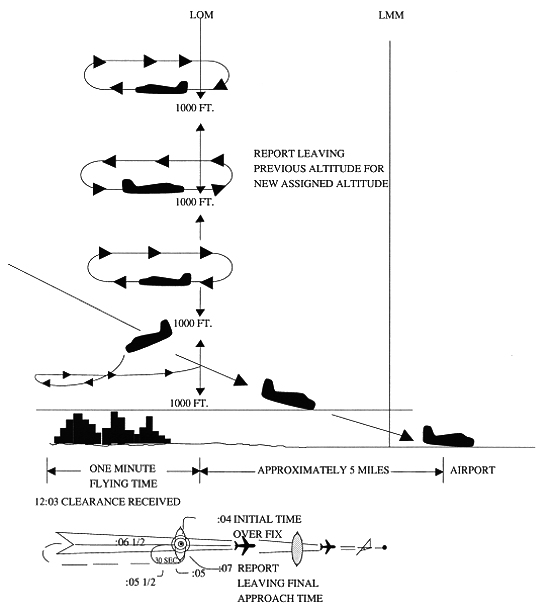
EXAMPLE-
At 12:03 local time, in the example shown, a pilot holding,
receives instructions to leave the fix inbound at 12:07.
These instructions are received just as the pilot has
completed turn at the outbound end of the holding pattern
and is proceeding inbound towards the fix. Arriving back
over the fix, the pilot notes that the time is 12:04 and
that there are 3 minutes to lose in order to leave the fix
at the assigned time. Since the time remaining is more than
two minutes, the pilot plans to fly a race track pattern
rather than a 360 degree turn, which would use up 2 minutes.
The turns at the ends of the race track pattern will consume
approximately 2 minutes. Three minutes to go, minus 2
minutes required for the turns, leaves 1 minute for level
flight. Since two portions of level flight will be required
to get back to the fix inbound, the pilot halves the 1
minute remaining and plans to fly level for 30 seconds
outbound before starting the turn back to the fix on final
approach. If the winds were negligible at flight altitude,
this procedure would bring the pilot inbound across the fix
precisely at the specified time of 12:07. However, if
expecting headwind on final approach, the pilot should
shorten the 30 second outbound course somewhat, knowing that
the wind will carry the aircraft away from the fix faster
while outbound and decrease the ground speed while returning
to the fix. On the other hand, compensating for a tailwind
on final approach, the pilot should lengthen the calculated
30 second outbound heading somewhat, knowing that the wind
would tend to hold the aircraft closer to the fix while
outbound and increase the ground speed while returning to
the fix.
5-4-11.
Radar Approaches
a. The only
airborne radio equipment required for radar approaches is a
functioning radio transmitter and receiver. The radar
controller vectors the aircraft to align it with the runway
centerline. The controller continues the vectors to keep the
aircraft on course until the pilot can complete the approach
and landing by visual reference to the surface. There are
two types of radar approaches: Precision (PAR) and
Surveillance (ASR).
b. A radar
approach may be given to any aircraft upon request and may
be offered to pilots of aircraft in distress or to expedite
traffic, however, an ASR might not be approved unless there
is an ATC operational requirement, or in an unusual or
emergency situation. Acceptance of a PAR or ASR by a pilot
does not waive the prescribed weather minimums for the
airport or for the particular aircraft operator concerned.
The decision to make a radar approach when the reported
weather is below the established minimums rests with the
pilot.
c. PAR and ASR
minimums are published on separate pages in the FAA Terminal
Procedures Publication (TPP).
1. A PRECISION
APPROACH (PAR) is one in which a controller provides
highly accurate navigational guidance in azimuth and
elevation to a pilot. Pilots are given headings to fly, to
direct them to, and keep their aircraft aligned with the
extended centerline of the landing runway. They are told to
anticipate glidepath interception approximately 10 to 30
seconds before it occurs and when to start descent. The
published Decision Height will be given only if the pilot
requests it. If the aircraft is observed to deviate above or
below the glidepath, the pilot is given the relative amount
of deviation by use of terms "slightly" or "well" and is
expected to adjust the aircraft's rate of descent/ascent to
return to the glidepath. Trend information is also issued
with respect to the elevation of the aircraft and may be
modified by the terms "rapidly" and "slowly"; e.g., "well
above glidepath, coming down rapidly." Range from touchdown
is given at least once each mile. If an aircraft is observed
by the controller to proceed outside of specified safety
zone limits in azimuth and/or elevation and continue to
operate outside these prescribed limits, the pilot will be
directed to execute a missed approach or to fly a specified
course unless the pilot has the runway environment (runway,
approach lights, etc.) in sight. Navigational guidance in
azimuth and elevation is provided the pilot until the
aircraft reaches the published Decision Height (DH).
Advisory course and glidepath information is furnished by
the controller until the aircraft passes over the landing
threshold, at which point the pilot is advised of any
deviation from the runway centerline. Radar service is
automatically terminated upon completion of the approach.
2. A SURVEILLANCE
APPROACH (ASR) is one in which a controller
provides navigational guidance in azimuth only. The pilot is
furnished headings to fly to align the aircraft with the
extended centerline of the landing runway. Since the radar
information used for a surveillance approach is considerably
less precise than that used for a precision approach, the
accuracy of the approach will not be as great and higher
minimums will apply. Guidance in elevation is not possible
but the pilot will be advised when to commence descent to
the Minimum Descent Altitude (MDA) or, if appropriate, to an
intermediate step-down fix Minimum Crossing Altitude and
subsequently to the prescribed MDA. In addition, the pilot
will be advised of the location of the Missed Approach Point
(MAP) prescribed for the procedure and the aircraft's
position each mile on final from the runway, airport or
heliport or MAP, as appropriate. If requested by the pilot,
recommended altitudes will be issued at each mile, based on
the descent gradient established for the procedure, down to
the last mile that is at or above the MDA. Normally,
navigational guidance will be provided until the aircraft
reaches the MAP. Controllers will terminate guidance and
instruct the pilot to execute a missed approach unless at
the MAP the pilot has the runway, airport or heliport in
sight or, for a helicopter point-in-space approach, the
prescribed visual reference with the surface is established.
Also, if, at any time during the approach the controller
considers that safe guidance for the remainder of the
approach cannot be provided, the controller will terminate
guidance and instruct the pilot to execute a missed
approach. Similarly, guidance termination and missed
approach will be effected upon pilot request and, for civil
aircraft only, controllers may terminate guidance when the
pilot reports the runway, airport/heliport or visual surface
route (point-in-space approach) in sight or otherwise
indicates that continued guidance is not required. Radar
service is automatically terminated at the completion of a
radar approach.
NOTE-
1. The published MDA for straight-in
approaches will be issued to the pilot before beginning
descent. When a surveillance approach will terminate in a
circle-to-land maneuver, the pilot must furnish the aircraft
approach category to the controller. The controller will
then provide the pilot with the appropriate MDA.
2. ASR
APPROACHES ARE NOT AVAILABLE WHEN AN ATC FACILITY IS USING
CENRAP.
3. A NO-GYRO
APPROACH is available to a pilot under radar control who
experiences circumstances wherein the directional gyro or
other stabilized compass is inoperative or inaccurate. When
this occurs, the pilot should so advise ATC and request a
No-Gyro vector or approach. Pilots of aircraft not equipped
with a directional gyro or other stabilized compass who
desire radar handling may also request a No-Gyro vector or
approach. The pilot should make all turns at standard rate
and should execute the turn immediately upon receipt of
instructions. For example, "TURN RIGHT," "STOP TURN." When a
surveillance or precision approach is made, the pilot will
be advised after the aircraft has been turned onto final
approach to make turns at half standard rate.
5-4-12.
Radar Monitoring of Instrument Approaches
a. PAR
facilities operated by the FAA and the military services at
some joint-use (civil and military) and military
installations monitor aircraft on instrument approaches and
issue radar advisories to the pilot when weather is below
VFR minimums (1,000 and 3), at night, or when requested by a
pilot. This service is provided only when the PAR Final
Approach Course coincides with the final approach of the
navigational aid and only during the operational hours of
the PAR. The radar advisories serve only as a secondary aid
since the pilot has selected the navigational aid as the
primary aid for the approach.
b. Prior to
starting final approach, the pilot will be advised of the
frequency on which the advisories will be transmitted. If,
for any reason, radar advisories cannot be furnished, the
pilot will be so advised.
c. Advisory
information, derived from radar observations, includes
information on:
1. Passing the
final approach fix inbound (nonprecision approach) or
passing the outer marker or fix used in lieu of the outer
marker inbound (precision approach).
NOTE-
At this point, the pilot may be requested to report sighting
the approach lights or the runway.
2. Trend
advisories with respect to elevation and/or azimuth radar
position and movement will be provided.
NOTE-
Whenever the aircraft nears the PAR safety limit, the pilot
will be advised that the aircraft is well above or below the
glidepath or well left or right of course. Glidepath
information is given only to those aircraft executing a
precision approach, such as ILS or MLS. Altitude information
is not transmitted to aircraft executing other than
precision approaches because the descent portions of these
approaches generally do not coincide with the depicted PAR
glidepath. At locations where the MLS glidepath and PAR
glidepath are not coincidental, only azimuth monitoring will
be provided.
3. If, after
repeated advisories, the aircraft proceeds outside the PAR
safety limit or if a radical deviation is observed, the
pilot will be advised to execute a missed approach unless
the prescribed visual reference with the surface is
established.
d. Radar
service is automatically terminated upon completion of the
approach.
5-4-13.
ILS/MLS Approaches to Parallel Runways
a. ATC
procedures permit ILS instrument approach operations to dual
or triple parallel runway configurations. ILS/MLS approaches
to parallel runways are grouped into three classes: Parallel
(dependent) ILS/MLS Approaches; Simultaneous Parallel
(independent) ILS/MLS Approaches; and Simultaneous Close
Parallel (independent) ILS Precision Runway Monitor (PRM)
Approaches. (See FIG
5-4-15.) The classification of
a parallel runway approach procedure is dependent on
adjacent parallel runway centerline separation, ATC
procedures, and airport ATC radar monitoring and
communications capabilities. At some airports one or more
parallel localizer courses may be offset up to 3 degrees.
Offset localizer configurations result in loss of Category
II capabilities and an increase in decision height (50').
b. Parallel
approach operations demand heightened pilot situational
awareness. A thorough Approach Procedure Chart review should
be conducted with, as a minimum, emphasis on the following
approach chart information: name and number of the approach,
localizer frequency, inbound localizer/azimuth course, glide
slope intercept altitude, decision height, missed approach
instructions, special notes/procedures, and the assigned
runway location/proximity to adjacent runways. Pilots will
be advised that simultaneous ILS/MLS or simultaneous close
parallel ILS PRM approaches are in use. This information may
be provided through the ATIS.
c. The close
proximity of adjacent aircraft conducting simultaneous
parallel ILS/MLS and simultaneous close parallel ILS PRM
approaches mandates strict pilot compliance with all ATC
clearances. ATC assigned airspeeds, altitudes, and headings
must be complied with in a timely manner. Autopilot coupled
ILS/MLS approaches require pilot knowledge of procedures
necessary to comply with ATC instructions. Simultaneous
parallel ILS/MLS and simultaneous close parallel ILS PRM
approaches necessitate precise localizer tracking to
minimize final monitor controller intervention, and unwanted
No Transgression Zone (NTZ) penetration. In the unlikely
event of a breakout, ATC will not assign altitudes lower
than the minimum vectoring altitude. Pilots should notify
ATC immediately if there is a degradation of aircraft or
navigation systems.
d. Strict
radio discipline is mandatory during parallel ILS/MLS
approach operations. This includes an alert listening watch
and the avoidance of lengthy, unnecessary radio
transmissions. Attention must be given to proper call sign
usage to prevent the inadvertent execution of clearances
intended for another aircraft. Use of abbreviated call signs
must be avoided to preclude confusion of aircraft with
similar sounding call signs. Pilots must be alert to
unusually long periods of silence or any unusual background
sounds in their radio receiver. A stuck microphone may block
the issuance of ATC instructions by the final monitor
controller during simultaneous parallel ILS/MLS and
simultaneous close parallel ILS PRM approaches.
REFERENCE-
AIM, Chapter
4,
Section
2, Radio
Communications Phraseology and Techniques, gives additional
communications information.
e. Use of
Traffic Collision Avoidance Systems (TCAS) provides an
additional element of safety to parallel approach
operations. Pilots should follow recommended TCAS operating
procedures presented in approved flight manuals, original
equipment manufacturer recommendations, professional
newsletters, and FAA publications.
FIG
5-4-15
Parallel ILS Approaches
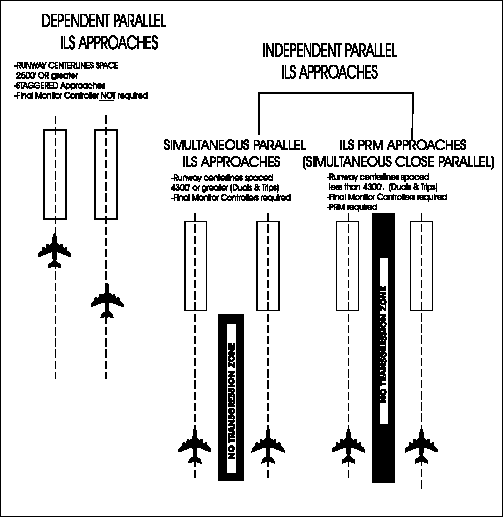
5-4-14.
Parallel ILS/MLS Approaches (Dependent)
(See FIG
5-4-16.)
FIG
5-4-16
Staggered ILS Approaches
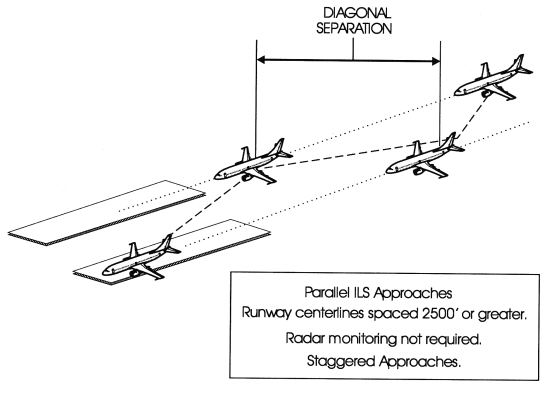
a. Parallel
approaches are an ATC procedure permitting parallel ILS/MLS
approaches to airports having parallel runways separated by
at least 2,500 feet between centerlines. Integral
parts of a total system are ILS/MLS, radar, communications,
ATC procedures, and required airborne equipment.
b. A parallel
(dependent) approach differs from a simultaneous
(independent) approach in that, the minimum distance between
parallel runway centerlines is reduced; there is no
requirement for radar monitoring or advisories; and a
staggered separation of aircraft on the adjacent
localizer/azimuth course is required.
c. Aircraft
are afforded a minimum of 1.5 miles radar separation
diagonally between successive aircraft on the adjacent
localizer/azimuth course when runway centerlines are at
least 2,500 feet but no more than 4,300 feet apart. When
runway centerlines are more than 4,300 feet but no more than
9,000 feet apart a minimum of 2 miles diagonal radar
separation is provided. Aircraft on the same
localizer/azimuth course within 10 miles of the runway end
are provided a minimum of 2.5 miles radar separation. In
addition, a minimum of 1,000 feet vertical or a minimum of
three miles radar separation is provided between aircraft
during turn on to the parallel final approach course.
d. Whenever
parallel ILS/MLS approaches are in progress, pilots are
informed that approaches to both runways are in use. In
addition, the radar controller will have the interphone
capability of communicating with the tower controller where
separation responsibility has not been delegated to the
tower.
5-4-15.
Simultaneous Parallel ILS/MLS Approaches (Independent)
(See FIG
5-4-17.)
FIG
5-4-17
Simultaneous Parallel ILS Approaches
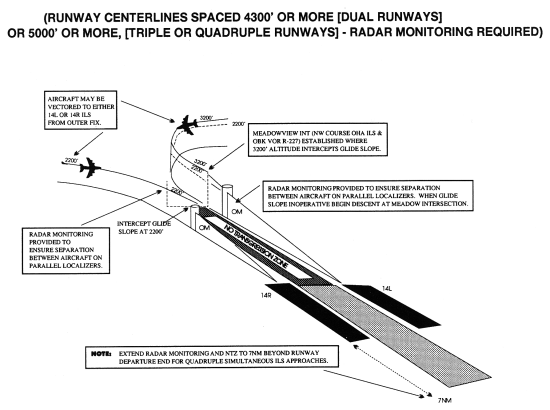
a. System. An
approach system permitting simultaneous ILS/MLS approaches
to parallel runways with centerlines separated by 4,300 to
9,000 feet, and equipped with final monitor
controllers. Simultaneous parallel ILS/MLS approaches
require radar monitoring to ensure separation between
aircraft on the adjacent parallel approach course. Aircraft
position is tracked by final monitor controllers who will
issue instructions to aircraft observed deviating from the
assigned localizer course. Staggered radar separation
procedures are not utilized. Integral parts of a total
system are ILS/MLS, radar, communications, ATC procedures,
and required airborne equipment. The Approach Procedure
Chart permitting simultaneous parallel ILS/MLS approaches
will contain the note "simultaneous approaches authorized
RWYS 14L and 14R," identifying the appropriate runways
as the case may be. When advised that simultaneous parallel
ILS/MLS approaches are in progress, pilots shall advise
approach control immediately of malfunctioning or
inoperative receivers, or if a simultaneous parallel ILS/MLS
approach is not desired.
b.
Radar Monitoring. This service is provided for each
simultaneous parallel ILS/MLS approach to ensure aircraft do
not deviate from the final approach course. Radar monitoring
includes instructions if an aircraft nears or penetrates the
prescribed NTZ (an area 2,000 feet wide located equidistant
between parallel final approach courses). This service will
be provided as follows:
1. During turn
on to parallel final approach, aircraft will be provided 3
miles radar separation or a minimum or 1,000 feet vertical
separation. The assigned altitude must be maintained until
intercepting the glide path, unless cleared otherwise by
ATC. Aircraft will not be vectored to intercept the final
approach course at an angle greater than thirty degrees.
2. The final
monitor controller will have the capability of overriding
the tower controller on the tower frequency.
3. Pilots will
be instructed to monitor the tower frequency to receive
advisories and instructions.
4. Aircraft
observed to overshoot the turn-on or to continue on a track
which will penetrate the NTZ will be instructed to return to
the correct final approach course immediately. The final
monitor controller may also issue missed approach or
breakout instructions to the deviating aircraft.
PHRASEOLOGY-
"(Aircraft call sign) YOU HAVE CROSSED THE FINAL APPROACH
COURSE. TURN (left/right) IMMEDIATELY AND RETURN TO THE
LOCALIZER/AZIMUTH COURSE,"
or
"(aircraft call sign) TURN (left/right) AND RETURN TO THE
LOCALIZER/AZIMUTH COURSE."
5. If a
deviating aircraft fails to respond to such instructions or
is observed penetrating the NTZ, the aircraft on the
adjacent final approach course may be instructed to alter
course.
PHRASEOLOGY-
"TRAFFIC ALERT (aircraft call sign) TURN (left/right)
IMMEDIATELY HEADING (degrees), (climb/descend) AND MAINTAIN
(altitude)."
6. Radar
monitoring will automatically be terminated when visual
separation is applied, the aircraft reports the approach
lights or runway in sight, or the aircraft is 1 mile or less
from the runway threshold (for runway centerlines spaced
4,300 feet or greater). Final monitor controllers will
not advise pilots when radar monitoring is
terminated.
5-4-16.
Simultaneous Close Parallel ILS PRM Approaches (Independent)
and
Simultaneous Offset Instrument Approaches (SOIA) (See
FIG
5-4-18.)
FIG
5-4-18
ILS PRM Approaches
(Simultaneous Close Parallel)
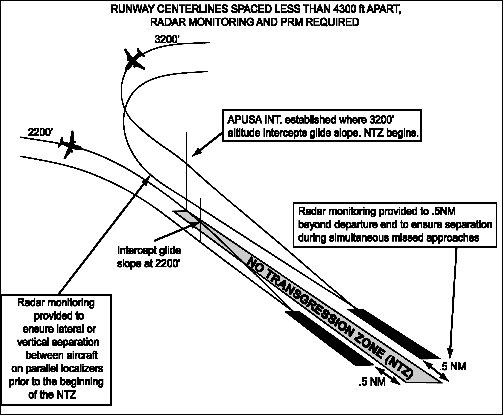
a.
System.
1. ILS/PRM is
an acronym for Instrument Landing System/Precision Runway
Monitor.
(a) An
approach system that permits simultaneous ILS/PRM approaches
to dual runways with centerlines separated by less
than 4,300 feet but at least 3,400 feet for parallel
approach courses, and at least 3,000 feet if one ILS if
offset by 2.5 to 3.0 degrees. The airspace between the
final approach courses contains a No Transgression Zone
(NTZ) with surveillance provided by two PRM monitor
controllers, one for each approach course. To qualify for
reduced lateral runway separation, monitor controllers must
be equipped with high update radar and high resolution ATC
radar displays, collectively called a PRM system. The PRM
system displays almost instantaneous radar information.
Automated tracking software provides PRM monitor controllers
with aircraft identification, position, speed and a
ten-second projected position, as well as visual and aural
controller alerts. The PRM system is a supplemental
requirement for simultaneous close parallel approaches in
addition to the system requirements for simultaneous
parallel ILS/MLS approaches described in paragraph
5-4-15,
Simultaneous Parallel ILS/MLS Approaches (Independent).
(b)
Simultaneous close parallel ILS/PRM approaches are
depicted on a separate Approach Procedure Chart titled
ILS/PRM Rwy XXX (Simultaneous Close Parallel).
2. SOIA is an
acronym for Simultaneous Offset Instrument Approach, a
procedure used to conduct simultaneous approaches to runways
spaced less than 3,000 feet, but at least 750 feet apart.
The SOIA procedure utilizes an ILS/PRM approach to one
runway and an offset Localizer Type Directional Aid
(LDA)/PRM approach with glide slope to the adjacent runway.
(a) The
ILS/PRM approach plates used in SOIA operations are
identical to other ILS/PRM approach plates, with an
additional note, which provides the separation between the
two runways used for simultaneous approaches. The LDA/PRM
approach plate displays the required notations for closely
spaced approaches as well as depicting the visual segment of
the approach, and a note that provides the separation
between the two runways used for simultaneous operations.
(b)
Controllers monitor the SOIA ILS/PRM and LDA/PRM
approaches with a PRM system using high update radar and
high-resolution ATC radar displays in exactly the same
manner as is done for ILS/PRM approaches. The procedures and
system requirements for SOIA ILS/PRM and LDA/PRM approaches
are identical with those used for simultaneous close
parallel ILS/PRM approaches until near the LDA/PRM approach
missed approach point (MAP)---where visual acquisition of
the ILS aircraft by the LDA aircraft must be accomplished.
Since the ILS/PRM and LDA/PRM approaches are identical
except for the visual segment in the SOIA concept, an
understanding of the procedures for conducting ILS/PRM
approaches is essential before conducting a SOIA ILS/PRM or
LDA/PRM operation.
(c) In SOIA,
the approach course separation (instead of the runway
separation) meets established close parallel approach
criteria. Refer to FIG
5-4-19 for the generic SOIA
approach geometry. A visual segment of the LDA/PRM approach
is established between the LDA MAP and the runway threshold.
Aircraft transition in visual conditions from the LDA
course, beginning at the LDA MAP, to align with the runway
and can be stabilized by 500 feet above ground level
(AGL) on the extended runway centerline. Aircraft will be
"paired" in SOIA operations, with the ILS aircraft ahead of
the LDA aircraft prior to the LDA aircraft reaching the LDA
MAP. A cloud ceiling for the approach is established so that
the LDA aircraft has nominally 30 seconds to acquire the
leading ILS aircraft prior to the LDA aircraft reaching the
LDA MAP. If visual acquisition is not accomplished, a missed
approach must be executed.
b.
Requirements.
Besides system
requirements as identified in subpara a
above all pilots must have completed special training before
accepting a clearance to conduct ILS/PRM or LDA/PRM
Simultaneous Close Parallel Approaches.
1. Pilot Training
Requirement. Pilots must complete special pilot
training, as outlined below, before accepting a
clearance for a simultaneous close parallel ILS/PRM or
LDA/PRM approach.
(a) For
operations under 14 CFR Parts 121, 129, and 135 pilots must
comply with FAA approved company training as identified in
their Operations Specifications. Training, at a minimum,
must require pilots to view the FAA video "ILS PRM AND SOIA
APPROACHES: INFORMATION FOR AIR CARRIER PILOTS." Refer to
http://www.faa.gov for additional information and to
view or download the video.
(b) For
operations under Part 91:
(1) Pilots
operating transport category aircraft must be
familiar with PRM operations as contained in this section of
the Aeronautical Information Manual (AIM). In addition,
pilots operating transport category aircraft must
view the FAA video "ILS PRM AND SOIA APPROACHES: INFORMATION
FOR AIR CARRIER PILOTS." Refer to http://www.faa.gov
for additional information and to view or download the
video.
FIG
5-4-19
SOIA Approach Geometry
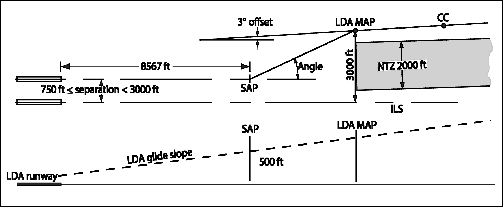
NOTE-
|
SAP
|
The SAP is
a design point along the extended centerline of the
intended landing runway on the glide slope at 500
feet above the landing threshold. It is used to
verify a sufficient distance is provided for the
visual maneuver after the missed approach point
(MAP) to permit the pilots to conform to approved,
stabilized approach criteria.
|
|
MAP
|
The point
along the LDA where the course separation with the
adjacent ILS reaches 3,000 feet. The altitude of
the glide slope at that point determines the
approach minimum descent altitude and is where the
NTZ terminates. Maneuvering inside the MAP is done
in visual conditions.
|
|
Angle
|
Angle
formed at the intersection of the extended LDA
runway centerline and a line drawn between the LDA
MAP and the SAP. The size of the angle is
determined by the FAA SOIA computer design program,
and is dependent on whether Heavy aircraft use the
LDA and the spacing between the runways.
|
|
Visibility
|
Distance
from MAP to runway threshold in statute miles
(light credit applies).
|
|
Procedure
|
LDA
aircraft must see the runway landing environment
and, if less than standard radar separation exists
between the aircraft on the adjacent ILS course,
the LDA aircraft must visually acquire the ILS
aircraft and report it in sight to ATC prior to the
LDA MAP.
|
|
CC
|
Clear
Clouds.
|
(2) Pilots
not operating transport category aircraft must
be familiar with PRM and SOIA operations as contained in
this section of the AIM. The FAA strongly recommends that
pilots not involved in transport category
aircraft operations view the FAA video, "ILS PRM AND SOIA
APPROACHES: INFORMATION FOR GENERAL AVIATION PILOTS." Refer
to http://www.faa.gov for additional information and
to view or download the video.
2. ATC Directed
Breakout. An ATC directed "breakout" is defined as a
vector off the ILS or LDA approach course in response to
another aircraft penetrating the NTZ, the 2,000 foot wide
area located equidistance between the two approach courses
that is monitored by the PRM monitor controllers.
3. Dual
Communications. The aircraft flying the ILS/PRM or
LDA/PRM approach must have the capability of enabling the
pilot/s to listen to two communications frequencies
simultaneously.
c.
Radar Monitoring. Simultaneous close parallel ILS/PRM
and LDA/PRM approaches require that final monitor
controllers utilize the PRM system to ensure prescribed
separation standards are met. Procedures and communications
phraseology are also described in paragraph 5-4-15,
Simultaneous Parallel ILS/MLS Approaches (Independent). A
minimum of 3 miles radar separation or 1,000 feet vertical
separation will be provided during the turn-on to close
parallel final approach courses. To ensure separation is
maintained, and in order to avoid an imminent situation
during simultaneous close parallel ILS/PRM or SOIA ILS/PRM
and LDA/PRM approaches, pilots must immediately comply with
PRM monitor controller instructions. In the event of a
missed approach, radar monitoring is provided to one-half
mile beyond the most distant of the two runway departure
ends for ILS/RPM approaches. In SOIA, PRM radar monitoring
terminates at the LDA MAP. Final monitor controllers will
not notify pilots when radar monitoring is
terminated.
d. Attention All
Users Page (AAUP). ILS/PRM and LDA/PRM approach charts
have an AAUP associated with them that must be referred to
in preparation for conducting the approach. This page
contains the following instructions that must be followed if
the pilot is unable to accept an ILS/PRM or LDA/PRM
approach.
1. At airports
that conduct PRM operations, (ILS/PRM or, in the case of
airports where SOIAs are conducted, ILS/PRM and LDA/PRM
approaches) pilots not qualified to except PRM approaches
must contact the FAA Command Center prior to departure
(1-800-333-4286) to obtain an arrival reservation (see FAA
Advisory Circular 90-98, Simultaneous Closely Spaced
Parallel Operations at Airports Using Precision Runway
Monitor (PRM) Systems). Arriving flights that are unable to
participate in ILS/PRM or LDA/PRM approaches and have not
received an arrival reservation are subject to diversion to
another airport or delays. Pilots en route to a PRM airport
designated as an alternate, unable to reach their filed
destination, and who are not qualified to participate in
ILS/PRM or LDA/PRM approaches must advise ATC as soon as
practical that they are unable to participate. Pilots who
are qualified to participate but experience an en route
equipment failure that would preclude participation in PRM
approaches should notify ATC as soon as practical.
2. The AAUP
covers the following operational topics:
(a) ATIS. When
the ATIS broadcast advises ILS/PRM approaches are in
progress (or ILS PRM and LDA PRM approaches in the case of
SOIA), pilots should brief to fly the ILS/PRM or LDA/PRM
approach. If later advised to expect the ILS or LDA approach
(should one be published), the ILS/PRM or LDA/PRM chart may
be used after completing the following briefing items:
(1) Minimums
and missed approach procedures are unchanged.
(2) PRM
Monitor frequency no longer required.
(3) ATC may
assign a lower altitude for glide slope intercept.
NOTE-
In the case of the LDA/PRM approach, this briefing procedure
only applies if an LDA approach is also published.
In the case of the
SOIA ILS/PRM and LDA/PRM procedure, the AAUP describes the
weather conditions in which simultaneous approaches are
authorized:
Simultaneous approach
weather minimums are X,XXX feet (ceiling), x miles
(visibility).
(b) Dual VHF
Communications Required. To avoid blocked transmissions,
each runway will have two frequencies, a primary and a
monitor frequency. The tower controller will transmit on
both frequencies. The monitor controller's transmissions, if
needed, will override both frequencies. Pilots will ONLY
transmit on the tower controller's frequency, but will
listen to both frequencies. Begin to monitor the PRM monitor
controller when instructed by ATC to contact the tower. The
volume levels should be set about the same on both radios so
that the pilots will be able to hear transmissions on at
least one frequency if the other is blocked. Site specific
procedures take precedence over the general information
presented in this paragraph. Refer to the AAUP for
applicable procedures at specific airports.
(c)
Breakouts. Breakouts differ from other types of
abandoned approaches in that they can happen anywhere and
unexpectedly. Pilots directed by ATC to break off an
approach must assume that an aircraft is blundering toward
them and a breakout must be initiated immediately.
(1) Hand-fly
breakouts. All breakouts are to be hand-flown to ensure
the maneuver is accomplished in the shortest amount of time.
(2) ATC Directed
"Breakouts." ATC directed breakouts will consist of a
turn and a climb or descent. Pilots must always initiate the
breakout in response to an air traffic controller's
instruction. Controllers will give a descending breakout
only when there are no other reasonable options available,
but in no case will the descent be below the minimum
vectoring altitude (MVA) which provides at least 1,000 feet
required obstruction clearance. The AAUP provides the MVA in
the final approach segment as X,XXX feet at (Name) Airport.
NOTE-
"TRAFFIC ALERT." If an aircraft enters the "NO TRANSGRESSION
ZONE" (NTZ), the controller will breakout the threatened
aircraft on the adjacent approach. The phraseology for the
breakout will be:
PHRASEOLOGY-
TRAFFIC ALERT, (aircraft call sign) TURN (left/right)
IMMEDIATELY, HEADING (degrees), CLIMB/DESCEND AND MAINTAIN
(altitude).
(d)
ILS/PRM Navigation. The pilot may find crossing
altitudes along the final approach course. The pilot is
advised that descending on the ILS glideslope ensures
complying with any charted crossing restrictions.
SOIA AAUP
differences from ILS PRM AAUP
(e)
ILS/PRM LDA Traffic (only published on ILS/PRM AAUP when the
ILS PRM approach is used in conjunctions with an LDA/PRM
approach to the adjacent runway). To provide better
situational awareness, and because traffic on the LDA may be
visible on the ILS aircraft's TCAS, pilots are reminded of
the fact that aircraft will be maneuvering behind them to
align with the adjacent runway. While conducting the ILS/PRM
approach to Runway XXX, other aircraft may be conducting the
offset LDA/PRM approach to Runway XXX. These aircraft will
approach from the (left/right)-rear and will realign with
runway XXX after making visual contact with the ILS traffic.
Under normal circumstances these aircraft will not pass the
ILS traffic.
SOIA LDA/PRM AAUP
Items. The AAUP for the SOIA LDA/PRM approach contains
most information found on ILS/PRM AAUPs. It replaces certain
information as seen below and provides pilots with the
procedures to be used in the visual segment of the LDA/PRM
approach, from the time the ILS aircraft is visually
acquired until landing.
(f) SOIA LDA/PRM
Navigation (replaces ILS/PRM (d)
and (e)
above). The pilot may find crossing altitudes along the
final approach course. The pilot is advised that descending
on the LDA glideslope ensures complying with any charted
crossing restrictions. Remain on the LDA course until
passing XXXXX (LDA MAP name) intersection prior to
maneuvering to align with the centerline of runway XXX.
(g) SOIA (Name)
Airport Visual Segment (replaces ILS/PRM
(e)
above). Pilot procedures for navigating beyond the LDA
MAP are spelled out. If ATC advises that there is traffic on
the adjacent ILS, pilots are authorized to continue past the
LDA MAP to align with runway centerline when:
(1) the ILS
traffic is in sight and is expected to remain in sight,
(2) ATC has
been advised that "traffic is in sight."
(3) the runway
environment is in sight.
Otherwise, a missed
approach must be executed. Between the LDA MAP and the
runway threshold, pilots of the LDA aircraft are responsible
for separating themselves visually from traffic on the ILS
approach, which means maneuvering the aircraft as necessary
to avoid the ILS traffic until landing, and providing wake
turbulence avoidance, if applicable. Pilots should advise
ATC, as soon as practical, if visual contact with the ILS
traffic is lost and execute a missed approach unless
otherwise instructed by ATC.
e. SOIA LDA
Approach Wake Turbulence. Pilots are responsible for
wake turbulence avoidance when maneuvering between the LDA
missed approach point and the runway threshold.
f.
Differences between ILS and ILS/PRM approaches of importance
to the pilot.
1. Runway
Spacing. Prior to ILS/PRM and LDA/PRM approaches, most
ATC directed breakouts were the result of two aircraft
in-trail on the same final approach course getting too close
together. Two aircraft going in the same direction did
not mandate quick reaction times. With PRM approaches, two
aircraft could be along side each other, navigating on
courses that are separated by less than 4,300 feet. In the
unlikely event that an aircraft "blunders" off its course
and makes a worst case turn of 30 degrees toward the
adjacent final approach course, closing speeds of 135 feet
per second could occur that constitute the need for quick
reaction. A blunder has to be recognized by the monitor
controller, and breakout instructions issued to the
endangered aircraft. The pilot will not have any warning
that a breakout is imminent because the blundering aircraft
will be on another frequency. It is important that, when a
pilot receives breakout instructions, he/she assumes that a
blundering aircraft is about to or has penetrated the NTZ
and is heading toward his/her approach course. The pilot
must initiate a breakout as soon as safety allows. While
conducting PRM approaches, pilots must maintain an increased
sense of awareness in order to immediately react to an ATC
instruction (breakout) and maneuver as instructed by
ATC, away from a blundering aircraft.
2.
Communications. To help in avoiding communication
problems caused by stuck microphones and two parties talking
at the same time, two frequencies for each runway will be in
use during ILS/PRM and LDA/PRM approach operations, the
primary tower frequency and the PRM monitor frequency. The
tower controller transmits and receives in a normal fashion
on the primary frequency and also transmits on the PRM
monitor frequency. The monitor controller's transmissions
override on both frequencies. The pilots flying the approach
will listen to both frequencies but only transmit on the
primary tower frequency. If the PRM monitor controller
initiates a breakout and the primary frequency is blocked by
another transmission, the breakout instruction will still be
heard on the PRM monitor frequency.
3. Hand-flown
Breakouts. The use of the autopilot is encouraged while
flying an ILS/PRM or LDA/PRM approach, but the autopilot
must be disengaged in the rare event that a breakout is
issued. Simulation studies of breakouts have shown that a
hand-flown breakout can be initiated consistently faster
than a breakout performed using the autopilot.
4. TCAS. The
ATC breakout instruction is the primary means of conflict
resolution. TCAS, if installed, provides another form of
conflict resolution in the unlikely event other separation
standards would fail. TCAS is not required to conduct a
closely spaced approach.
The TCAS provides
only vertical resolution of aircraft conflicts, while the
ATC breakout instruction provides both vertical and
horizontal guidance for conflict resolutions. Pilots should
always immediately follow the TCAS Resolution Advisory (RA),
whenever it is received. Should a TCAS RA be received
before, during, or after an ATC breakout instruction is
issued, the pilot should follow the RA, even if it conflicts
with the climb/descent portion of the breakout maneuver. If
following an RA requires deviating from an ATC clearance,
the pilot shall advise ATC as soon as practical. While
following an RA, it is extremely important that the pilot
also comply with the turn portion of the ATC breakout
instruction unless the pilot determines safety to be factor.
Adhering to these procedures assures the pilot that
acceptable "breakout" separation margins will always be
provided, even in the face of a normal procedural or system
failure.
5. Breakouts.
The probability is extremely low that an aircraft will
"blunder" from its assigned approach course and enter the
NTZ, causing ATC to "breakout" the aircraft approaching on
the adjacent ILS course. However, because of the close
proximity of the final approach courses, it is essential
that pilots follow the ATC breakout instructions precisely
and expeditiously. The controller's "breakout" instructions
provide conflict resolution for the threatened aircraft,
with the turn portion of the "breakout" being the single
most important element in achieving maximum protection. A
descending breakout will only be issued when it is the only
controller option. In no case will the controller descend an
aircraft below the MVA, which will provide at least 1,000
feet clearance above obstacles. The pilot is not expected to
exceed 1,000 feet per minute rate of descent in the event a
descending breakout is issued.
5-4-17.
Simultaneous Converging Instrument Approaches
a. ATC may
conduct instrument approaches simultaneously to converging
runways; i.e., runways having an included angle from 15 to
100 degrees, at airports where a program has been
specifically approved to do so.
b. The basic
concept requires that dedicated, separate standard
instrument approach procedures be developed for each
converging runway included. Missed Approach Points must be
at least 3 miles apart and missed approach procedures ensure
that missed approach protected airspace does not overlap.
c. Other
requirements are: radar availability, nonintersecting final
approach courses, precision (ILS/MLS) approach systems on
each runway and, if runways intersect, controllers must be
able to apply visual separation as well as intersecting
runway separation criteria. Intersecting runways also
require minimums of at least 700 foot ceilings and 2 miles
visibility. Straight in approaches and landings must be
made.
d. Whenever
simultaneous converging approaches are in progress, aircraft
will be informed by the controller as soon as feasible after
initial contact or via ATIS. Additionally, the radar
controller will have direct communications capability with
the tower controller where separation responsibility has not
been delegated to the tower.
5-4-18.
RNP SAAAR Instrument Approach Procedures
These procedures
require authorization analogous to the special authorization
required for Category II or III ILS procedures. Special
aircraft and aircrew authorization required (SAAAR)
procedures are to be conducted by aircrews meeting special
training requirements in aircraft that meet the specified
performance and functional requirements.
a. Unique
characteristics of RNP SAAAR Approaches
1. RNP value.
Each published line of minima has an associated RNP
value. The indicated value defines the lateral and vertical
performance requirements. A minimum RNP type is documented
as part of the RNP SAAAR authorization for each operator and
may vary depending on aircraft configuration or operational
procedures (e.g., GPS inoperative, use of flight director
vice autopilot).
2. Curved path
procedures. Some RNP approaches have a curved path, also
called a radius-to-a-fix (RF) leg. Since not all aircraft
have the capability to fly these arcs, pilots are
responsible for knowing if they can conduct an RNP approach
with an arc or not. Aircraft speeds, winds and bank angles
have been taken into consideration in the development of the
procedures.
3. RNP required
for extraction or not. Where required, the missed
approach procedure may use RNP values less than RNP-1. The
reliability of the navigation system has to be very high in
order to conduct these approaches. Operation on these
procedures generally requires redundant equipment, as no
single point of failure can cause loss of both approach and
missed approach navigation.
4. Non-standard
speeds or climb gradients. RNP SAAAR approaches are
developed based on standard approach speeds and a 200 ft/NM
climb gradient in the missed approach. Any exceptions to
these standards will be indicated on the approach procedure,
and the operator should ensure they can comply with any
published restrictions before conducting the operation.
5. Temperature
Limits. For aircraft using barometric vertical
navigation (without temperature compensation) to conduct the
approach, low and high-temperature limits are identified on
the procedure. Cold temperatures reduce the glidepath angle
while high temperatures increase the glidepath angle.
Aircraft using baro VNAV with temperature compensation or
aircraft using an alternate means for vertical guidance
(e.g., SBAS) may disregard the temperature restrictions. The
charted temperature limits are evaluated for the final
approach segment only. Regardless of charted temperature
limits or temperature compensation by the FMS, the pilot may
need to manually compensate for cold temperature on minimum
altitudes and the decision altitude.
6. Aircraft
size. The achieved minimums may be dependent on aircraft
size. Large aircraft may require higher minimums due to gear
height and/or wingspan. Approach procedure charts will be
annotated with applicable aircraft size restrictions.
b.
Types of RNP SAAAR Approach Operations
1. RNP Stand-alone
Approach Operations. RNP SAAAR procedures can provide
access to runways regardless of the ground-based NAVAID
infrastructure, and can be designed to avoid obstacles,
terrain, airspace, or resolve environmental constraints.
2. RNP Parallel
Approach (RPA) Operations. RNP SAAAR procedures can be
used for parallel approaches where the runway separation is
adequate (See FIG
5-4-20). Parallel approach
procedures can be used either simultaneously or as
stand-alone operations. They may be part of either
independent or dependent operations depending on the ATC
ability to provide radar monitoring.
FIG
5-4-20
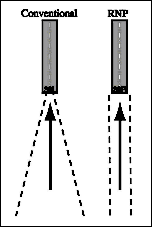
3. RNP Parallel
Approach Runway Transitions (RPAT) Operations. RPAT
approaches begin as a parallel IFR approach operation using
simultaneous independent or dependent procedures. (See FIG
5-4-21). Visual separation
standards are used in the final segment of the approach
after the final approach fix, to permit the RPAT aircraft to
transition in visual conditions along a predefined lateral
and vertical path to align with the runway centerline.
FIG
5-4-21
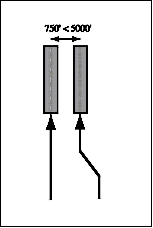
4. RNP Converging
Runway Operations. At airports where runways converge,
but may or may not intersect, an RNP SAAAR approach can
provide a precise curved missed approach path that conforms
to aircraft separation minimums for simultaneous operations
(See FIG
5-4-22). By flying this curved
missed approach path with high accuracy and containment
provided by RNP, dual runway operations may continue to be
used to lower ceiling and visibility values than currently
available. This type of operation allows greater capacity at
airports where it can be applied.
FIG
5-4-22
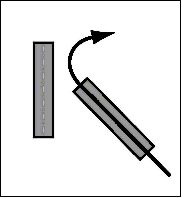
5-4-19.
Side-step Maneuver
a. ATC may
authorize a standard instrument approach procedure which
serves either one of parallel runways that are separated by
1,200 feet or less followed by a straight-in landing on the
adjacent runway.
b. Aircraft
that will execute a side-step maneuver will be cleared for a
specified approach procedure and landing on the adjacent
parallel runway. Example, "cleared ILS runway 7 left
approach, side-step to runway 7 right." Pilots are expected
to commence the side-step maneuver as soon as possible after
the runway or runway environment is in sight.
NOTE-
Side-step minima are flown to a Minimum Descent Altitude
(MDA) regardless of the approach authorized.
c. Landing
minimums to the adjacent runway will be based on
nonprecision criteria and therefore higher than the
precision minimums to the primary runway, but will normally
be lower than the published circling minimums.
5-4-20.
Approach and Landing Minimums
a. Landing
Minimums. The rules applicable to landing minimums are
contained in 14 CFR Section 91.175. TBL
5-4-1 may be used to convert
RVR to ground or flight visibility. For converting RVR
values that fall between listed values, use the next higher
RVR value; do not interpolate. For example, when converting
1800 RVR, use 2400 RVR with the resultant visibility
of 1/2 mile.
TBL
5-4-1
RVR Value
Conversions
|
RVR
|
Visibility
(statute miles)
|
|
1600
|
1/4
|
|
2400
|
1/2
|
|
3200
|
5/8
|
|
4000
|
3/4
|
|
4500
|
7/8
|
|
5000
|
1
|
|
6000
|
1
1/4
|
b. Obstacle
Clearance. Final approach obstacle clearance is provided
from the start of the final segment to the runway or missed
approach point, whichever occurs last. Side-step obstacle
protection is provided by increasing the width of the final
approach obstacle clearance area.
1. Circling
approach protected areas are defined by the tangential
connection of arcs drawn from each runway end. The arc radii
distance differs by aircraft approach category. Because of
obstacles near the airport, a portion of the circling area
may be restricted by a procedural note: e.g., "Circling NA E
of RWY 17-35." Obstacle clearance is provided at the
published minimums for the pilot that makes a straight-in
approach, side-steps, circles, or executes the missed
approach. Missed approach obstacle clearance requirements
may dictate the published minimums for the approach. (See
FIG
5-4-23.)
FIG
5-4-23
Final Approach Obstacle Clearance
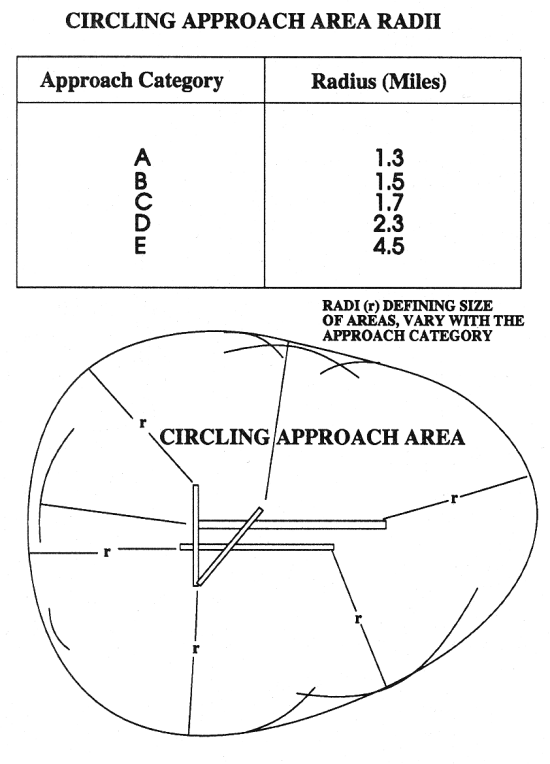
2.
Precision Obstacle Free Zone (POFZ). A volume of
airspace above an area beginning at the runway threshold, at
the threshold elevation, and centered on the extended runway
centerline. The POFZ is 200 feet (60m) long and 800 feet
(240m) wide. The POFZ must be clear when an aircraft on a
vertically guided final approach is within 2 nautical miles
of the runway threshold and the reported ceiling is below
250 feet or visibility less than
3/4
statute mile (SM) (or runway visual range below 4,000 feet).
If the POFZ is not clear, the MINIMUM authorized height
above touchdown (HAT) and visibility is 250 feet and
3/4
SM. The POFZ is considered
clear even if the wing of the aircraft holding on a taxiway
waiting for runway clearance penetrates the POFZ; however,
neither the fuselage nor the tail may infringe on the POFZ.
The POFZ is applicable at all runway ends including
displaced thresholds.
FIG
5-4-24
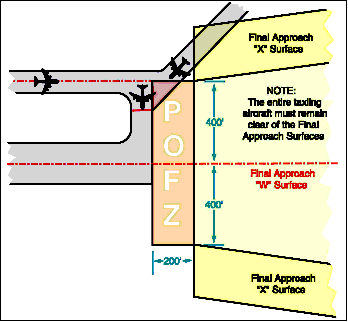
NOTE-
The target date for mandatory POFZ compliance from every
airport nationally is January 1, 2007.
c.
Straight-in Minimums are shown on the IAP when the final
approach course is within 30 degrees of the runway alignment
(15 degrees for GPS IAPs) and a normal descent can be made
from the IFR altitude shown on the IAP to the runway
surface. When either the normal rate of descent or the
runway alignment factor of 30 degrees (15 degrees for GPS
IAPs) is exceeded, a straight-in minimum is not published
and a circling minimum applies. The fact that a straight-in
minimum is not published does not preclude pilots from
landing straight-in if they have the active runway in sight
and have sufficient time to make a normal approach for
landing. Under such conditions and when ATC has cleared them
for landing on that runway, pilots are not expected to
circle even though only circling minimums are published. If
they desire to circle, they should advise ATC.
d. Side-Step
Maneuver Minimums. Landing minimums for a side-step
maneuver to the adjacent runway will normally be higher than
the minimums to the primary runway.
e. Published
Approach Minimums. Approach minimums are published for
different aircraft categories and consist of a minimum
altitude (DA, DH, MDA) and required visibility. These
minimums are determined by applying the appropriate TERPS
criteria. When a fix is incorporated in a nonprecision final
segment, two sets of minimums may be published: one for the
pilot that is able to identify the fix, and a second for the
pilot that cannot. Two sets of minimums may also be
published when a second altimeter source is used in the
procedure. When a nonprecision procedure incorporates both a
stepdown fix in the final segment and a second altimeter
source, two sets of minimums are published to account for
the stepdown fix and a note addresses minimums for the
second altimeter source.
f.
Circling Minimums. In some busy terminal areas, ATC may
not allow circling and circling minimums will not be
published. Published circling minimums provide obstacle
clearance when pilots remain within the appropriate area of
protection. Pilots should remain at or above the circling
altitude until the aircraft is continuously in a position
from which a descent to a landing on the intended runway can
be made at a normal rate of descent using normal maneuvers.
Circling may require maneuvers at low altitude, at low
airspeed, and in marginal weather conditions. Pilots must
use sound judgment, have an indepth knowledge of their
capabilities, and fully understand the aircraft performance
to determine the exact circling maneuver since weather,
unique airport design, and the aircraft position, altitude,
and airspeed must all be considered. The following basic
rules apply:
1. Maneuver
the shortest path to the base or downwind leg, as
appropriate, considering existing weather conditions. There
is no restriction from passing over the airport or other
runways.
2. It should
be recognized that circling maneuvers may be made while VFR
or other flying is in progress at the airport. Standard left
turns or specific instruction from the controller for
maneuvering must be considered when circling to land.
3. At airports
without a control tower, it may be desirable to fly over the
airport to observe wind and turn indicators and other
traffic which may be on the runway or flying in the vicinity
of the airport.
g. Instrument
Approach at a Military Field. When instrument approaches
are conducted by civil aircraft at military airports, they
shall be conducted in accordance with the procedures and
minimums approved by the military agency having jurisdiction
over the airport.
5-4-21.
Missed Approach
a. When a
landing cannot be accomplished, advise ATC and, upon
reaching the missed approach point defined on the approach
procedure chart, the pilot must comply with the missed
approach instructions for the procedure being used or with
an alternate missed approach procedure specified by ATC.
b. Obstacle
protection for missed approach is predicated on the missed
approach being initiated at the decision altitude/height
(DA/H) or at the missed approach point and not lower than
minimum descent altitude (MDA). A climb gradient of at least
200 feet per nautical mile is required, (except for Copter
approaches, where a climb of at least 400 feet per nautical
mile is required), unless a higher climb gradient is
published in the notes section of the approach procedure
chart. When higher than standard climb gradients are
specified, the end point of the non-standard climb will be
specified at either an altitude or a fix. Pilots must
preplan to ensure that the aircraft can meet the climb
gradient (expressed in feet per nautical mile) required by
the procedure in the event of a missed approach, and be
aware that flying at a higher than anticipated ground speed
increases the climb rate requirement (feet per minute).
Tables for the conversion of climb gradients (feet per
nautical mile) to climb rate (feet per minute), based on
ground speed, are included on page D1 of the U.S. Terminal
Procedures booklets. Reasonable buffers are provided for
normal maneuvers. However, no consideration is given to an
abnormally early turn. Therefore, when an early missed
approach is executed, pilots should, unless otherwise
cleared by ATC, fly the IAP as specified on the approach
plate to the missed approach point at or above the MDA or DH
before executing a turning maneuver.
c.
If visual reference is lost while circling-to-land from
an instrument approach, the missed approach specified for
that particular procedure must be followed (unless an
alternate missed approach procedure is specified by ATC). To
become established on the prescribed missed approach course,
the pilot should make an initial climbing turn toward the
landing runway and continue the turn until established on
the missed approach course. Inasmuch as the circling
maneuver may be accomplished in more than one direction,
different patterns will be required to become established on
the prescribed missed approach course, depending on the
aircraft position at the time visual reference is lost.
Adherence to the procedure will assure that an aircraft will
remain within the circling and missed approach obstruction
clearance areas. (See FIG
5-4-25.)
d. At
locations where ATC radar service is provided, the pilot
should conform to radar vectors when provided by ATC in lieu
of the published missed approach procedure. (See
FIG
5-4-26.)
e. Some
locations may have a preplanned alternate missed approach
procedure for use in the event the primary NAVAID used for
the missed approach procedure is unavailable. To avoid
confusion, the alternate missed approach instructions are
not published on the chart. However, the alternate missed
approach holding pattern will be depicted on the instrument
approach chart for pilot situational awareness and to assist
ATC by not having to issue detailed holding instructions.
The alternate missed approach may be based on NAVAIDs not
used in the approach procedure or the primary missed
approach. When the alternate missed approach procedure is
implemented by NOTAM, it becomes a mandatory part of the
procedure. The NOTAM will specify both the textual
instructions and any additional equipment requirements
necessary to complete the procedure. Air traffic may also
issue instructions for the alternate missed approach when
necessary, such as when the primary missed approach NAVAID
fails during the approach. Pilots may reject an ATC
clearance for an alternate missed approach that requires
equipment not necessary for the published approach procedure
when the alternate missed approach is issued after beginning
the approach. However, when the alternate missed approach is
issued prior to beginning the approach the pilot must either
accept the entire procedure (including the alternate missed
approach), request a different approach procedure, or
coordinate with ATC for alternative action to be taken,
i.e., proceed to an alternate airport, etc.
f. When
approach has been missed, request clearance for specific
action; i.e., to alternative airport, another approach, etc.
g. Pilots must
ensure that they have climbed to a safe altitude prior to
proceeding off the published missed approach, especially in
nonradar environments. Abandoning the missed approach prior
to reaching the published altitude may not provide adequate
terrain clearance. Additional climb may be required after
reaching the holding pattern before proceeding back to the
IAF or to an alternate.
FIG
5-4-25
Circling and Missed Approach Obstruction Clearance
Areas
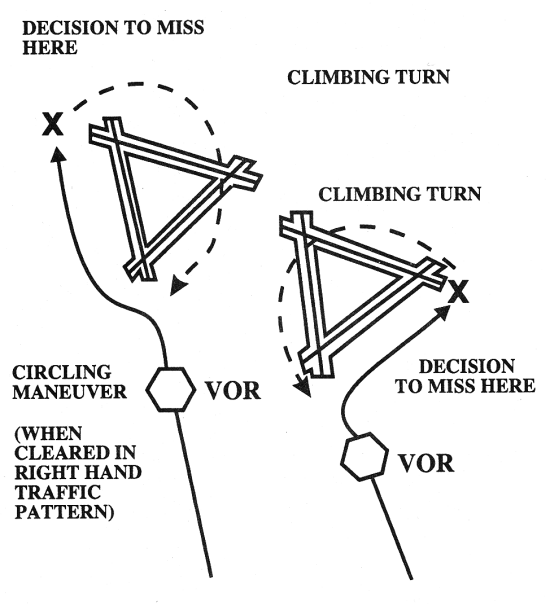
FIG
5-4-26
Missed Approach
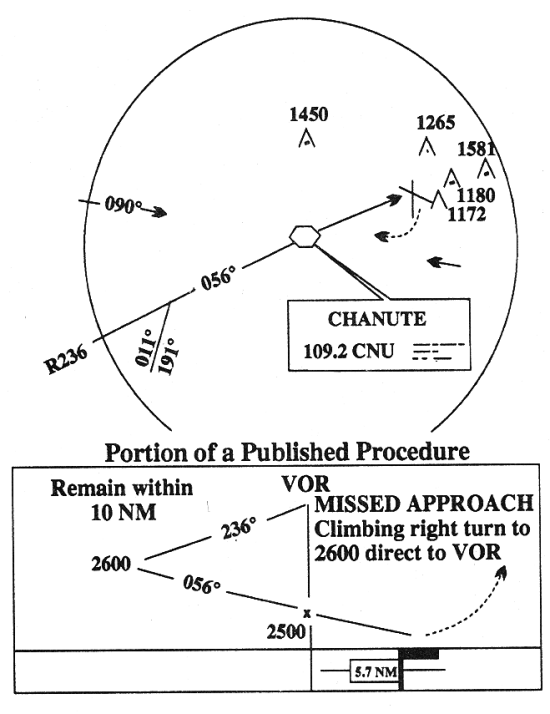
h.
Missed approach obstacle clearance is predicated on
beginning the missed approach procedure at the Missed
Approach Point (MAP) from MDA or DA and then climbing 200
feet/NM or greater. Initiating a go-around after passing the
published MAP may result in total loss of obstacle
clearance. To compensate for the possibility of reduced
obstacle clearance during a go-around, a pilot should apply
procedures used in takeoff planning. Pilots should refer to
airport obstacle and departure data prior to initiating an
instrument approach procedure. Such information may be found
in the "TAKE-OFF MINIMUMS AND (OBSTACLE) DEPARTURE
PROCEDURES" section of the U.S. TERMINAL PROCEDURES
publication.
5-4-22.
Visual Approach
a. A visual
approach is conducted on an IFR flight plan and authorizes a
pilot to proceed visually and clear of clouds to the
airport. The pilot must have either the airport or the
preceding identified aircraft in sight. This approach must
be authorized and controlled by the appropriate air traffic
control facility. Reported weather at the airport must have
a ceiling at or above 1,000 feet and visibility 3 miles or
greater. ATC may authorize this type approach when it will
be operationally beneficial. Visual approaches are an IFR
procedure conducted under IFR in visual meteorological
conditions. Cloud clearance requirements of 14 CFR Section
91.155 are not applicable, unless required by operation
specifications.
b. Operating to an
Airport Without Weather Reporting Service. ATC will
advise the pilot when weather is not available at the
destination airport. ATC may initiate a visual approach
provided there is a reasonable assurance that weather at the
airport is a ceiling at or above 1,000 feet and visibility 3
miles or greater (e.g., area weather reports, PIREPs, etc.).
c. Operating to an
Airport With an Operating Control Tower. Aircraft may be
authorized to conduct a visual approach to one runway while
other aircraft are conducting IFR or VFR approaches to
another parallel, intersecting, or converging runway. When
operating to airports with parallel runways separated by
less than 2,500 feet, the succeeding aircraft must report
sighting the preceding aircraft unless standard separation
is being provided by ATC. When operating to parallel runways
separated by at least 2,500 feet but less than 4,300 feet,
controllers will clear/vector aircraft to the final at an
angle not greater than 30 degrees unless radar, vertical, or
visual separation is provided during the turn-on. The
purpose of the 30 degree intercept angle is to reduce the
potential for overshoots of the final and to preclude
side-by-side operations with one or both aircraft in a
belly-up configuration during the turn-on. Once the aircraft
are established within 30 degrees of final, or on the
final, these operations may be conducted simultaneously.
When the parallel runways are separated by 4,300 feet or
more, or intersecting/converging runways are in use, ATC may
authorize a visual approach after advising all aircraft
involved that other aircraft are conducting operations to
the other runway. This may be accomplished through use of
the ATIS.
d.
Separation Responsibilities. If the pilot has the
airport in sight but cannot see the aircraft to be followed,
ATC may clear the aircraft for a visual approach; however,
ATC retains both separation and wake vortex separation
responsibility. When visually following a preceding
aircraft, acceptance of the visual approach clearance
constitutes acceptance of pilot responsibility for
maintaining a safe approach interval and adequate wake
turbulence separation.
e. A visual
approach is not an IAP and therefore has no missed approach
segment. If a go around is necessary for any reason,
aircraft operating at controlled airports will be issued an
appropriate advisory/clearance/instruction by the tower. At
uncontrolled airports, aircraft are expected to remain clear
of clouds and complete a landing as soon as possible. If a
landing cannot be accomplished, the aircraft is expected to
remain clear of clouds and contact ATC as soon as possible
for further clearance. Separation from other IFR aircraft
will be maintained under these circumstances.
f. Visual
approaches reduce pilot/controller workload and expedite
traffic by shortening flight paths to the airport. It is the
pilot's responsibility to advise ATC as soon as possible if
a visual approach is not desired.
g.
Authorization to conduct a visual approach is an IFR
authorization and does not alter IFR flight plan
cancellation responsibility.
REFERENCE-
AIM, Canceling IFR Flight Plan, Paragraph
5-1-14.
h. Radar
service is automatically terminated, without advising the
pilot, when the aircraft is instructed to change to advisory
frequency.
5-4-23.
Charted Visual Flight Procedure (CVFP)
a. CVFPs are
charted visual approaches established for
environmental/noise considerations, and/or when necessary
for the safety and efficiency of air traffic operations. The
approach charts depict prominent landmarks, courses, and
recommended altitudes to specific runways. CVFPs are
designed to be used primarily for turbojet aircraft.
b. These
procedures will be used only at airports with an operating
control tower.
c. Most
approach charts will depict some NAVAID information which is
for supplemental navigational guidance only.
d. Unless
indicating a Class B airspace floor, all depicted altitudes
are for noise abatement purposes and are recommended only.
Pilots are not prohibited from flying other than recommended
altitudes if operational requirements dictate.
e. When
landmarks used for navigation are not visible at night, the
approach will be annotated "PROCEDURE NOT AUTHORIZED AT
NIGHT."
f. CVFPs
usually begin within 20 flying miles from the airport.
g. Published
weather minimums for CVFPs are based on minimum vectoring
altitudes rather than the recommended altitudes depicted on
charts.
h. CVFPs are
not instrument approaches and do not have missed approach
segments.
i. ATC will
not issue clearances for CVFPs when the weather is less than
the published minimum.
j. ATC will
clear aircraft for a CVFP after the pilot reports siting a
charted landmark or a preceding aircraft. If instructed to
follow a preceding aircraft, pilots are responsible for
maintaining a safe approach interval and wake turbulence
separation.
k. Pilots
should advise ATC if at any point they are unable to
continue an approach or lose sight of a preceding aircraft.
Missed approaches will be handled as a go-around.
5-4-24.
Contact Approach
a. Pilots
operating in accordance with an IFR flight plan, provided
they are clear of clouds and have at least 1 mile flight
visibility and can reasonably expect to continue to the
destination airport in those conditions, may request ATC
authorization for a contact approach.
b. Controllers
may authorize a contact approach provided:
1. The contact
approach is specifically requested by the pilot. ATC cannot
initiate this approach.
EXAMPLE-
Request contact approach.
2. The
reported ground visibility at the destination airport is at
least 1 statute mile.
3. The contact
approach will be made to an airport having a standard or
special instrument approach procedure.
4. Approved
separation is applied between aircraft so cleared and
between these aircraft and other IFR or special VFR
aircraft.
EXAMPLE-
Cleared contact approach (and, if required) at or below
(altitude) (routing) if not possible (alternative
procedures) and advise.
c. A contact
approach is an approach procedure that may be used by a
pilot (with prior authorization from ATC) in lieu of
conducting a standard or special IAP to an airport. It is
not intended for use by a pilot on an IFR flight clearance
to operate to an airport not having a published and
functioning IAP. Nor is it intended for an aircraft to
conduct an instrument approach to one airport and then, when
"in the clear," discontinue that approach and proceed to
another airport. In the execution of a contact approach, the
pilot assumes the responsibility for obstruction clearance.
If radar service is being received, it will automatically
terminate when the pilot is instructed to change to advisory
frequency.
5-4-25.
Landing Priority
A clearance for a
specific type of approach (ILS, MLS, ADF, VOR or Straight-in
Approach) to an aircraft operating on an IFR flight plan
does not mean that landing priority will be given over other
traffic. ATCTs handle all aircraft, regardless of the type
of flight plan, on a "first-come, first-served" basis.
Therefore, because of local traffic or runway in use, it may
be necessary for the controller in the interest of safety,
to provide a different landing sequence. In any case, a
landing sequence will be issued to each aircraft as soon as
possible to enable the pilot to properly adjust the
aircraft's flight path.
5-4-26.
Overhead Approach Maneuver
a. Pilots
operating in accordance with an IFR flight plan in Visual
Meteorological Conditions (VMC) may request ATC
authorization for an overhead maneuver. An overhead maneuver
is not an instrument approach procedure. Overhead maneuver
patterns are developed at airports where aircraft have an
operational need to conduct the maneuver. An aircraft
conducting an overhead maneuver is considered to be VFR and
the IFR flight plan is cancelled when the aircraft reaches
the initial point on the initial approach portion of the
maneuver. (See FIG
5-4-27.) The existence of a
standard overhead maneuver pattern does not eliminate the
possible requirement for an aircraft to conform to
conventional rectangular patterns if an overhead maneuver
cannot be approved. Aircraft operating to an airport without
a functioning control tower must initiate cancellation of an
IFR flight plan prior to executing the overhead maneuver.
Cancellation of the IFR flight plan must be accomplished
after crossing the landing threshold on the initial portion
of the maneuver or after landing. Controllers may authorize
an overhead maneuver and issue the following to arriving
aircraft:
1. Pattern
altitude and direction of traffic. This information may be
omitted if either is standard.
PHRASEOLOGY-
PATTERN ALTITUDE (altitude). RIGHT TURNS.
2. Request for
a report on initial approach.
PHRASEOLOGY-
REPORT INITIAL.
3.
"Break" information and a request for the pilot to
report. The "Break Point" will be specified if nonstandard.
Pilots may be requested to report "break" if required for
traffic or other reasons.
PHRASEOLOGY-
BREAK AT (specified point).
REPORT BREAK.
FIG
5-4-27
Overhead Maneuver
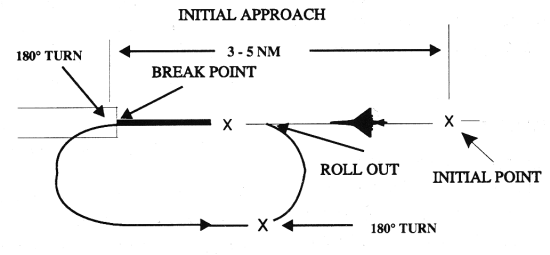
|


























